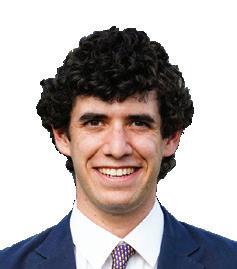

The Corne¬ Daily Sun


Kotlikof Reportedly Disapproves of Trump’s Higher Education Compact
By JOSHUA COHEN Sun Contributor
Oct. 19 — Cornell has not yet taken an official position on whether or not it would comply with demands from the Trump administration presented in its higher education compact in exchange for preferential funding treatment.
But at a press dinner with the leaders of 10 universities in New York City on Tuesday, Oct. 14, all — including President Michael Kotlikoff — did not raise their hands when asked if they would sign an agreement to these demands if asked by the administration, according to The New York Times.
“The compact itself requires institutions to make merit-based decisions on admissions and hiring, et cetera, which is perfectly reasonable, but it also creates a situation in which universities that sign the contract escape merit-based consideration for grants, et cetera,” Kotlikoff said, according to Inside Higher Ed. “They get special deals, and that is fundamentally inappropriate.”
The Trump administration’s “Compact for Academic Excellence
in Higher Education,” which was first offered to nine universities on Oct. 1, would require schools to freeze tuition for five years, cap international student enrollment at 15 percent and commit to strict definitions of gender in order to receive priority access to federal funding and looser restraints on overhead costs. This initial compact was later extended to all universities that want to “return to the pursuit of Truth and Achievement,” according to an Oct. 12 Truth Social post from President Trump.
None of the leaders present at the Oct. 14 meeting publicly confirmed that they had been sent invitations to sign the compact, according to Inside Higher Ed.
Last spring, the Trump administration froze hundreds of millions of dollars in research funding for Cornell, amid several ongoing federal civil rights investigations on campus.
To continue reading this article, please visit www.cornellsun.com.
jmc746@cornell.edu.
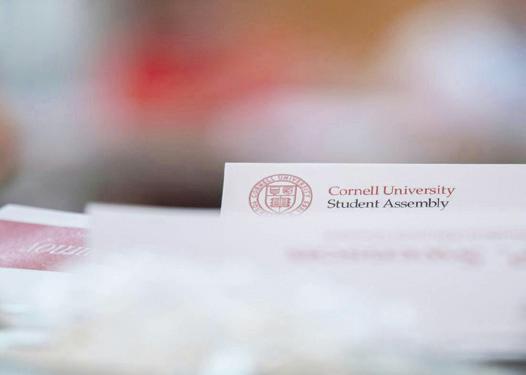

Over One Tousand Protesters Gather at ‘No Kings’ Rally
By SHUBHA GAUTUM Sun Senior Writer
Oct. 18 — Over one thousand people gathered at Washington Park in downtown Ithaca this Saturday as part of over 2,700 “No Kings” protests happening across the country.
Singing “if one of us is chained, none of us are free” and chanting “stand up, fight back,” protesters voiced dissent against President Donald Trump’s policies and presidency.
Over 100 volunteers from Indivisible Tompkins, a local organization formed in January that aims to support community members as they promote democracy through various events, hosted the rally alongside No Más Lágrimas and Citizen Action. Protesters, however, were not allowed to march as part of the event. Indivisible steering committee chair Ken McKinney said in a speech that, “The city asked us that if we were going to march, that we get a permit, and that requires insurance.”
While the city can require event organizers to provide liability insurance for non-expressive events, the requirement cannot act as a bar to First Amendment activity.
Attendees circled around the central stage holding signs, such as “Resist Fascism” and “I Like my ICE Crushed,” with others dressed up
in costumes mocking Trump. Children painted “No Kings” signs at the “Kids Corner,” which table volunteer Lisa Coniglio said was important to have for adults without a childcare option wishing to attend the rally.
The rally featured a speech from Rep. Anna Kelles (NY-125), in which she voiced support for New York State Assembly Bill 3506, which would regulate the disclosure of immigration status, increase renewable energy efforts, universal healthcare and other issues. Kelles said she wants to see “every single [person]” in the crowd writing to their legislators to express support for issues important to them.
“Yes, I have a voice, and, yes, I have a podium, but if you really want me to have lasting change, then stand with me to fight for the legislation that I’ve written in conversations that I’ve had with you,” Kelles said. “That is my tool. That is my strength, so stand with me.”
To continue reading this article, please visit www.cornellsun.com.
Shubha Gautum can be reached at sgautum@ cornellsun.com. Max Troiano contributed reporting.
No. 5 Women’s Hockey Opens to Weekend Sweep
By ELI FASTIFF Sun Senior Editor
Oct. 18 — For 50 minutes on Saturday afternoon, No. 5 women’s ice hockey seemed poised to repeat the Red’s dominant 3-0 season opening win. However, with a weekend sweep in hand thanks to a 4-0 lead, a small Cornell roster began to show its tired legs and gave up two Boston College goals in a span of six minutes to end the hopes of a weekend shutout.
“I thought it was a good game,” said senior defender Sarah MacEachern, who scored her first collegiate goal in the contest. “It’s our first weekend as a team, but I think we played together and we started off [the season] on the right foot.”
For the second day in a row, the first major scoring chance of the game came when junior goaltender Annelies Bergmann denied an Ava Thomas oneon-none opportunity in the opening minutes of the game. Thomas — who entered the weekend as the Eagles lead ing scorer — was denied multiple times by Bergmann throughout the afternoon.
“We gave up some grade-A chances early on and needed some big saves from Annelies [Bergmann]. “That was huge in both games because I didn’t think we had great starts in either one of them.”
Cornell (2-0-0, 0-0-0 ECAC) picked up an early power play oppor tunity when junior forward Karel

time on the ice and near
ly scored again multiple times in the
“All three of those players are going to be crucial,” said head coach Doug Derraugh ’91. “They are three of our top offensive players and they haven’t played together on a line like we’ve had. So, it was something we wanted to see.”
Cornell picked up its first penalty of the season when Adam was whistled for body-checking in the waning moments of the first frame, but a pair of Bergmann saves kept Cornell in front at the first intermission. After looking rusty at times in Friday’s first period and tying Boston College (3-4-0, 2-0shots on goal, the Red’s opening frame on Saturday was better with Cornell dominating the Cornell began the second period by killing the remaining 45 seconds of the Boston College power play, before a trio of unlikely skaters doubled the
Red’s lead.
7:49 into the period, a junior defender Abby Thibodeau shot from the left point deflected off a crowd of players and into the Eagle net. MacEachern was credited with the goal — her first as a Cornellian — and freshman Riley Scorgie also earned an assist for her first collegiate point.
“I was honestly thinking: ‘Why am I down in front of the net?’” MacEachern said with a laugh. “I honestly didn’t know if I scored or not.”
With the Eagles in the midst of their fifth scoreless period of the weekend, frustration began to boil over. Avar and a Boston College player became entangled after a whistle, and the Red earned its second power play when the Cornell forward was punched.
“The second period again seemed to be our best period,” Derraugh said. “I thought we put the pressure on them again and had a lot of chances, played a lot down in their zone.”
The final period was the most eventful of the weekend. Freshman forward Nora Curtis scored Cornell’s third goal of the game when she drove hard to the net, received a rebounding puck, and wristed it by Campbell for her first career goal.
To continue reading this article, please visit www.cornellsun.com.
Te Cornell Daily Sun signed an amicus brief in support of Te Stanford Daily’s ongoing lawsuit.
Prefontaine was tripped in front of
A LISTING OF FREE CAMPUS EVENTS

American Sign Language Conversation Hour 4 - 5 p.m., G25 Stimson Hall
Recharge with First-Gen Friends 4 - 6 p.m., 103 Robert Purcell Community Center Is (Cutting) International Aid Good? 5 - 6:30 p.m., G76 Goldwin Smith Hall
Upson


SUNBURSTS: Fall 2025 Photographer Spotlight
Over the last few weeks, Te Sun has welcomed new photographers — called compets — to the department. Here are some of their recent shots from their frst assignments for
By SUN PHOTOGRAPHY DEPARTMENT
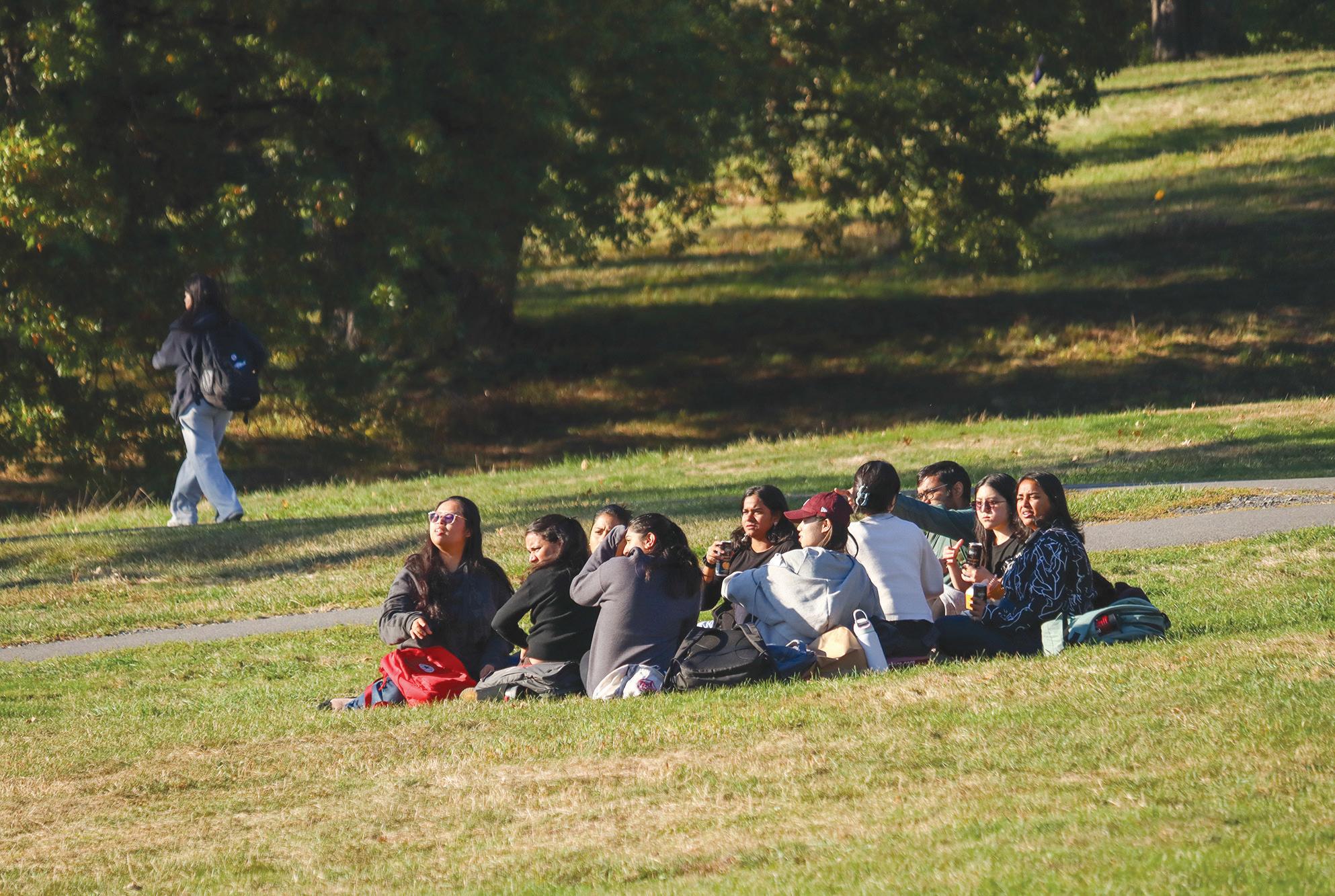


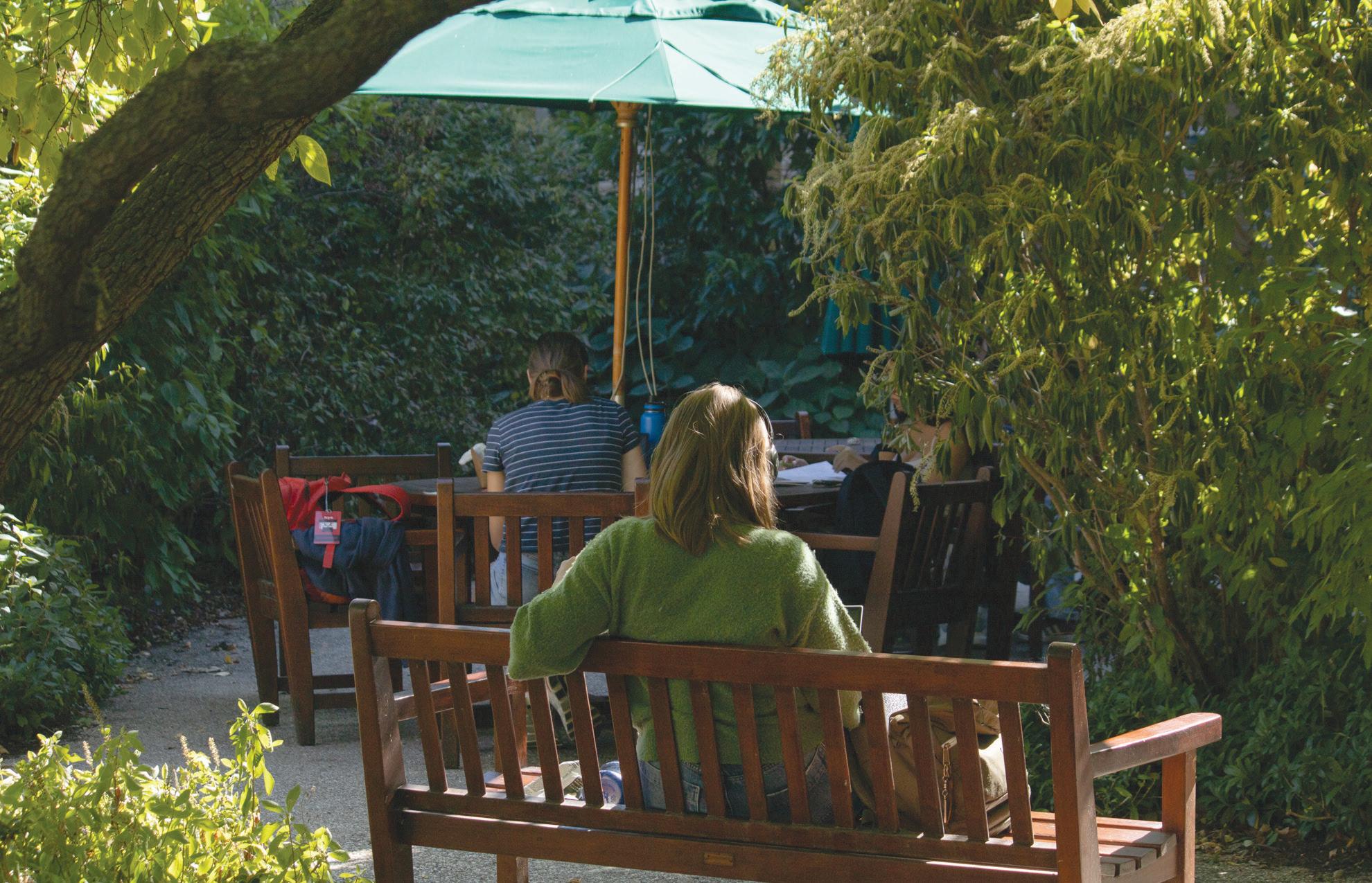




SLOPE STUDY SESH | Some students take advantage of the good weather to study on Libe Slope.
AUTUMN TREE | Some trees are changing colors on Central Campus.
COCKTAIL VIEWS | The sun sets over Uris Hall’s Cocktail Lounge as students study below.
TASTE OF AUTUMN | A tree begins to show the fall season outside of Bailey Hall.
SUNNY SLOPES AHEAD | Students walk down the Slope towards West Campus.
SIGHTS FROM COLLEGE AVE | Students walk down College Ave on a sunny fall day.
Te Sun.
Audrey Zhang / Sun Contributor
Photo
Nathan Bo / Sun Contributor
Rachel Choi / Sun Contributor
Julia Leavitt / Sun Staf Photographer
Samantha Miculinich / Sun Contributor
Sumedha Shastry / Sun Contributor
IVES SEE SHADES OF GREEN | Students studying outside Ives Hall.
BIG RED TOUR | A campus tour group walks down Ho Plaza.
Rosey Limmer / Sun Contributor
Rachel Choi / Sun Contributor
Te Sun Joins 54 Other College News Organizations, Leaders in Amicus Brief
By MATTHEW KIVIAT Sun Assistant Managing Editor
Oct. 16 — The Sun, along with 54 other college news organizations and leaders, signed an amicus brief on Wednesday in support of The Stanford Daily’s ongoing lawsuit against U.S. Secretary of State Marco Rubio and U.S. Secretary of Homeland Security Kristi Noem — Stanford Daily Publishing Corporation et al. v. Rubio et al.
The amicus brief, which is a statement that an individual or organization can sign and send to a court in support of a party in a lawsuit, was filed with the Student Press Law Center, the Associated Collegiate Press and the College Media Association. These three national groups work to support free press rights for student journalists.
The suit, filed on Aug. 6 on behalf of The Daily by the Foundation for Individual Rights and Expression — an organization seeking to protect and defend freedom of speech in the United States — contests two provisions from existing federal immigration law that it argues have been used to infringe on constitutionally protected speech.
The suit directly challenges two provisions from the 1952 Immigration and Nationality Act that would allow the Secretary of State to deport any noncitizen that the government deems to “compromise a compelling United States foreign policy interest” with their speech on campus and to revoke visas of noncitizens “at any time, in his discretion.”
According to the suit, legal noncitizen members of The Daily have
“self-censored” while writing about pro-Palestinian protests at Stanford or related political issues in fear of retaliation from the federal government. The suit claims that editors and staffers at The Daily have either had to quit the paper or request to remove online articles due to the government threats of “adverse immigration consequences.”
Greta Reich, the editor-in-chief at The Daily, wrote that the paper is losing a significant portion of student voices due to a “real fear on campus [that] reaches into the newsroom.”
“I’ve had reporters turn down assignments, request the removal of some of their articles and even quit the paper because they fear deportation for being associated with speaking on political topics, even in a journalistic capacity,” Reich wrote.
FIRE, which filed the suit on behalf of The Stanford Daily Publishing Corps, claims that the two provisions of the INA are unconstitutional due to their violations of the First Amendment of the U.S. Constitution, which prohibits the federal government from restricting the right to freedom of speech and of the press. The suit also alleges that the provisions violate the Fifth Amendment, which guarantees a citizen’s right to due process in legal proceedings, as the Constitution prohibits “vague laws” that could lead to arbitrary enforcement.
The brief emphasizes the importance of freedom of speech on college campuses, citing the “high-profile arrests” of student activists like Mahmoud Khalil, Mohsen Mahdawi and Rumeysa Ozturk in early 2025, which showed

the “audacious characterization of their speech as cause for removal from the United States.”
According to the amicus brief, The Daily’s suit highlights “the importance of the work of a student press that reflects a diverse range of viewpoints,” and how the “government’s attack on disfavored speech” has affected student-led newsrooms across the country.
The brief also asserts that both citizen and noncitizen journalists at student media outlets across the U.S. have seen their work “hampered for the better part of a year” due to the government’s actions.
The amicus brief calls for the court
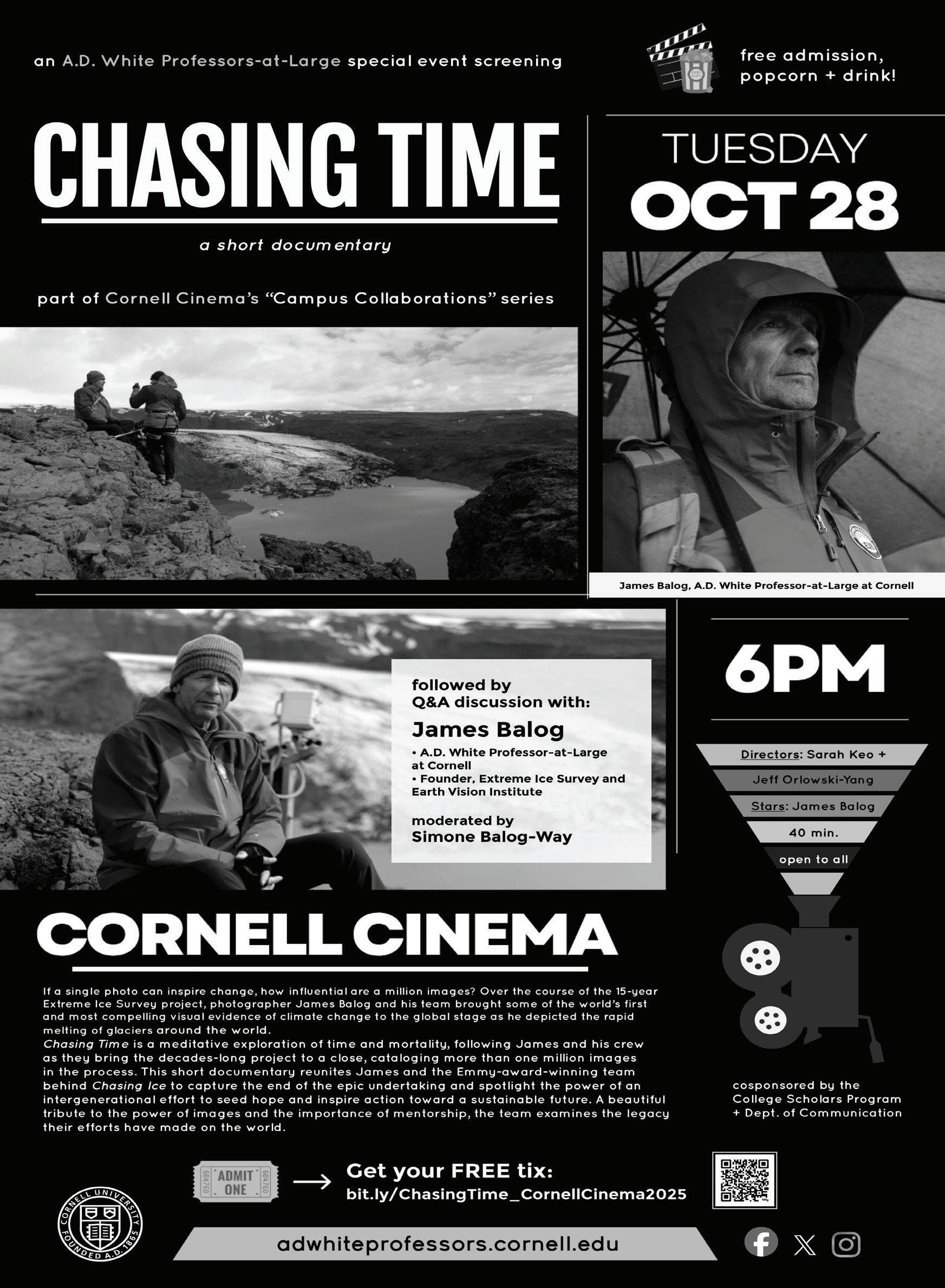
to grant The Daily’s challenge to the two provisions of the INA and stop the “defendants from unconstitutionally applying the Revocation Provision and Deportation Provision to punish international students for their protected speech activity.”
Conor Fitzpatrick, an attorney with FIRE, explained that the government’s threats regarding visa revocation and deportation due to speech contradict the U.S. Constitution.
To continue reading this article, please visit www.cornellsun.com.
Matthew Kiviat can be reached at mkiviat@cornellsun.com.
Canvas Outage Leaves Course Materials Inaccessible
By VARSHA BHARGAVA Sun News Editor
Oct. 20 — A Canvas blackout hit campus early Monday morning as a result of an Amazon Web Services global outage, according to AWS. The outage left students and faculty unable to access course materials, assignments and announcement blasts published on the site.
The Canvas outage officially ended at 7:16 p.m. on Monday evening, according to the Instructure site.
Canvas, an online learning management system, is widely used across campus as a primary method for assessment and communication between faculty, teaching staff and students. AWS, a cloud hosting service, is responsible for storing information and managing IT services for various sites, including Canvas.
AWS experienced a global outage on Monday morning that affected a range of companies including Snapchat, Roblox, United Airlines and Starbucks, rendering some temporarily unusable. Some issues have been resolved since.
“We are continuing to work with AWS into Canvas, Mastery Connect and other Instructure products being down,” read an update on the outage on the Instructure site at 11:07 a.m. on Monday.
Monday’s AWS outage marked the “the first major internet disruption since last year’s CrowdStrike malfunction,” which crashed millions of Microsoft Windows systems across campus and globally in July 2024, according to Reuters.
An error message reading “Canvas is experiencing issues due to an ongoing AWS incident” displayed across the screen when users attempted to access the Canvas website during the outage. The pop-up page recommended users follow the status of the blackout via the AWS site or the Instructure site.
To continue reading this article, please visit www.cornellsun.com.
Varsha Bhargava can be reached at vbhargava@cornellsun.com.
Legal letter | The Sun, along with 54 other college news organizations and leaders, signed an amicus brief on Wednesday to support The Stanford Daily’s free speech lawsuit.
KARLIE MCGANN / SUN PHOTOGRAPHY EDITOR
Cornell Law Professor Plans to File Civil Rights Complaint Against Cornell Over Cheyftz Case
By MATTHEW CHEN
Oct. 20 — Prof. William Jacobson, law, is preparing to file a civil rights complaint seeking a federal investigation into Cornell. His complaint argues that Cornell’s handling of the now-settled Eric Cheyfitz case resulted in the doxxing of Israeli graduate student Oren Renard.
Cheyfitz faced a discrimination investigation after he allegedly asked Renard to leave his spring course on Gaza, AIIS 3500: Gaza, Indigeneity, Resistance, claiming that he was “disruptive.” Cheyfitz chose to retire before the investigation could conclude, ending his disciplinary proceedings.
Jacobson plans to file the complaint with the Equal Protection Project, an organization he founded in 2023. According to their website, the EPP’s mission is to fight what they see as discrimination caused by diversity, equity and inclusion initiatives, such as exclusionary fellowship and scholarship programs across the country.
Previously, Jacobson and the EPP successfully initiated several federal investigations into both Ithaca College and the Ithaca City School District in 2024. The investigations targeted minority scholarship programs at Ithaca College and investigated discrimination around an ICSD Students of Color United Summit.
Jacobson’s complaint against Cornell has not yet been filed, but he said he plans to ask U.S. government agencies to investigate who leaked Renard’s identity, whether there was coordination behind the leak and how private information about the student and discrimination case were shared.
“Among other things, we will ask the Departments of Justice and Education to use the full resources at their disposal, including the power of subpoena and compelling testimony, to investigate this doxxing and retaliation against an Israeli student,” Jacobson wrote in an email statement to The Sun.
Jacobson emphasized the need for governmental investigation, particularly “in light of the federal investigations currently pending.” The University faces two pending antisemitism investigations which were cited by the Trump administration as the reason for the federal funding frozen from the University.
Alongside the request to investigate Renard’s case, Jacobson also plans to include in his complaint


a request to review the rules that give Cornell’s faculty committee binding authority over matters involving academic freedom and responsibility. He identifies the role of the Faculty Senate and some of its members as “concerning” and creating an environment where many Jewish students are subject to discrimination and fear of “doxxing, leaking and faculty activism.”
The Faculty Senate’s Committee on Academic Freedom and Professional Status of the Faculty was a point of contention during Cheyfitz’s case after the committee unanimously ruled in favor of Cheyfitz, contradicting Cornell’s Office of Civil Rights who found him in violation of federal anti-discrimination law. The Faculty Senate committee’s decision was later overturned and reinvestigated by Provost Kavita Bala, prompting the Faculty Senate to propose a resolution that called on the administration to accept the original finding by the committee.
Jacobson says that this proposed Faculty Senate
resolution and public statements from faculty contradict with civil rights laws and expose issues surrounding the shared governance model.
“The entire ‘shared governance’ model needs to be reexamined as it relates to the handling of alleged civil rights violations, and this case may be the opportunity for the Departments of Justice and Education to address that problem,” Jacobson wrote.
He also says the recent Faculty Senate resolution, which he claims contained “inflammatory political rhetoric” and “an attack on the administrative outcome” in the Cheyfitz case, oversteps the bounds of the Faculty Senate, which he says is supposed to have no role in the discrimination complaint process.
To continue reading this article, please visit www. cornellsun.com.

Sun Contributor
Cornell complaint | Prof. William Jacobson, law, plans to file a Civil Rights Complaint against Cornell over the Cheyfitz case.
Matthew Chen can be reached at mc2926@cornell.edu.
DANICA LEE / SUN STAFF PHOTOGRAPHER
The Corne¬ Daily Sun
Independent Since 1880
143rd Editorial Board
JULIA SENZON ’26
Editor in Chief
ERIC HAN ’26
Associate Editor
SOPHIA DASSER ’28
Opinion Editor
ILANA LIVSHITS ’27
Assistant Opinion Editor
SOPHIA TORRES ’26
Advertising Manager
SYDNEY LEVINTON ’27
Arts & Culture Editor
JAMES PALM ’27
Assistant Arts & Culture Editor
JENNA LEDLEY ’27
Assistant Arts & Culture Editor
MELISSA MOON ’28
Assistant Arts & Culture Editor
SOPHIA ROMANOV IMBER ’28
Assistant Arts & Culture Editor
KAITLYN BELL ’28
Lifestyle Editor
MAIA MEHRING ’27
Lifestyle Editor
KARLIE MCGANN ’27
Photography Editor
MATTHEW KORNICZKY ’28
Assistant Photography Editor
STEPHAN MENASCHE ’28
Assistant Photography Editor
MIRELLA BERKOWITZ ’27
Video Editor
JADE DUBUCHE ’27
Multimedia Editor
HANNIA AREVALO ’27
Graphics Editor
HUNTER PETMECKY ’28
Layout Editor
RENA GEULA ’28
Layout Editor
CHRISTOPHER WALKER ’26
Games Editor
Letter From the
Editor
IDOROTHY FRANCE-MILLER ’27
Managing Editor
MATTHEW KIVIAT ’27
Assistant Managing Editor
VERA SUN ’27
Business Manager
EMILY LEE ’27
Marketing Manager
ALEX LIEW ’27
Human Resources Manager
BENJAMIN LEYNSE ’27
News Editor
VARSHA BHARGAVA ’27
News Editor
ISABELLA HANSON ’27
News Editor
CEREESE QUSBA ’27
News Editor
REEM NASRALLAH ’28
Assistant News Editor
ANGELINA TANG ’28
Assistant News Editor
KATE TURK ’27
Assistant News Editor
GABRIEL MUÑOZ ’26
City Editor
JANE HAVILAND ’28
Features Editor
ZEINAB FARAJ ’28
Features Editor
JEREMIAH JUNG ’28
Assistant News Editor
KAITLIN CHUNG ’26
Science Editor
MARISSA GAUT ’27
Science Editor
ALEXIS ROGERS ’28
Sports Editor
SIMRAN LABORE ’27
Weather Editor
ALLISON HECHT ’26 Newsletter Editor
Te Sun Stands With Te Stanford Daily
ndependent student journalism exists to build a historical record and to keep institutions accountable. Once protected speech becomes a punishable offense, both our job and the virtue of our community is compromised.
It is with that understanding that The Sun joins 54 student news organizations and newsroom leaders in signing on to an amicus brief in support of The Stanford Daily in its free speech lawsuit, Stanford Daily Publishing Corporation et al. v. Rubio et al
The Constitution establishes First Amendment protections for both citizens and noncitizens. Thus, the suit and amicus brief challenge the unprecedented repression of international and noncitizen student voices.
The Stanford Daily’s lawsuit centers on U.S. Secretary of State Marco Rubio’s use of Immigration and Nationality Act provisions to cancel the visas of and deport lawfully present noncitizens over speech at odds with the federal government. The Student Press Law Center-led brief underscores how recent immigration enforcement actions have created an atmosphere of fear, hindering the work of independent student newspapers.
In May, The Sun’s Editorial Board condemned the detainment of Rumeysa Ozturk, a graduate student and Fulbright scholar at Tufts, with no warning and no identified crime, a year after Ozturk co-authored an op-ed urging Tufts to listen to student demands to end its connection to Israel. The editorial also denounced the detainment of journalists at Stanford and Dartmouth without institutional protection.
“Authoritarian regimes do not begin by silencing everyone — they start with students,” the editorial reads.
The signing of the amicus brief puts institutional action behind our words. It reflects The Sun’s longstanding values and the relevance of threats to free speech on Cornell’s campus.
In April, 17 current and former Cornell students saw their Student and Exchange Visitor Information System records revoked, and at
Sam Friedman
Sam Friedman is a senior in the College of Engineering. He can be reached at srf83@cornell.edu.
On Rhetoric and Responsibility
On Thursday, Sun Associate Editor Eric Han defended Professor Kassam’s op-ed and accompanying — albeit since-removed — painting which compare Israel to Nazi Germany.
Mr. Han correctly identifies something that it seems he, I and Dr. Kassam agree upon: the Nazis were evil. No reasonable person would suggest that Kassam or his artwork are pro-Nazi; on the contrary, he uses the evilness of the Nazis to cast the Jews as just as bad.
Anonymous Instagram page Cornellians Only covered the Sun’s publication and takedown of the painting, raising concern that the images constitute antisemitic Holocaust inversion.
Han quotes the Instagram account as follows (emphasis my own): “The painting’s combination of a core symbol of Judaism with the insignia of its perpetrators is a clear-cut example of Holocaust inversion, an anti-semitic trope that seeks to equate Jews and the state of Israel with the Nazis.”
Except, that’s not what the post said. Han has hyphenated the original “antisemitic” to read “anti-semitic.” The difference may seem insignificant, but the non-hyphenated spelling is widely recognized as the preferred form to refer to the hatred uniquely targeted towards Jews, not a vague “Semitic” group which the hyphenated form may imply. Whether his intention or not, Han’s edits delegitimize Jew hatred, even if ever-so-subtly, seemingly suggesting at least a lack of care, if not a lack of concern, for the problem.
Han argues that Kassam does not “equate” Israel with the Nazis because Kassam “makes no claim that Israel is wholesale equivalent to the Nazi regime” (emphasis my own). The claim that Kassam does not equate Israel to Nazi Germany because Israel is not literally “equal to Nazi Germany” is a ridiculous argument of semantics that cannot reasonably be argued in good faith. Kassam’s intention to compare Israel to Nazi Germany is clear to any reasonable observer.
Han echos Kassam’s claim that Israelis are only “not unlike” Nazis because they use “dehumanizing language” to describe Palestinians: “[the Israeli government] calls one ethnic group ‘animals.’”
October 7 attacks.
The only time the paper provides a direct quotation of an Israeli government official using “dehumanizing” language is when it quotes Israel’s Ambassador to Germany Ron Prosor as saying Israel is fighting “‘bloodthirsty animals’ of Hamas” (my emphasis). There is not one single example provided in the paper, Kassam’s article, or Han’s article, of the Israeli government referring to Palestinians as animals. Unless the authors seek to claim that all Palestinians are Hamas, a recognized terrorist group, which is to toss any semblance of humanity and civility away from all Palestinian people. (Kassam’s cited paper uses the term “Hamas/Palestinian” several times, seemingly equating the two groups.) As I recognize the Palestinians’ humanity and hope for their peace, I make no such claim.
But Han goes one step further than Kassam, claiming that Israel commits “genocide … in front of our eyes.” The genocide claim is refuted by Democrats, Republicans and most of the Western World. Han cites a disputed report from the notoriously anti-Israel United Nations. The issues with the report are numerous: insufficient demonstration of genocidal intent, inflation and miscategorization of casualties, and the one-sided nature of its criticisms, to name a few. But it is clear Han reached the “genocide” conclusion before the evidence — he has been claiming Israel committed genocide not only in Gaza, but also the West Bank, without evidence, since at least Febrary 2024.
My point is this: the claim that “Zionists” — terminology often used as a thinly veiled equivalent for “Jews,” which has long ties to antisemitism — are basically Nazis and literally genocidal is not only hateful, but causes real, sometimes deadly, harm to Jews around the world.
In framing Jews as as evil as the Nazis, you create a framework wherein attacking Jews is not only morally permissible, but almost a moral imperative. And it’s caught on.
least four of the 17 reported visa revocations.
Though all SEVIS records have since been restored, the message was clear. The federal government showed that students’ visa statuses, and thus their futures, are precarious.
In May, pro-Palestinian activist and then-international Ph.D. student Momodou Taal left the country after proclaiming that he believed the courts would no longer ensure his safety.
Taal had filed a lawsuit alongside Sriram Parasurama, a Ph.D. student in plant sciences, and Prof. Mukoma wa Ngugi, literatures in English, against the Trump administration for alleged First and Fifth Amendment rights violations with the implementation of two executive orders.
But Taal’s lawyers were sent an email requesting that he turn himself in to Immigration and Customs Enforcement and his request for a temporary restraining order was rejected, leading him to leave the country and his lawyers to retract the lawsuit.
At a university whose very motto is “any person, any study,” international and noncitizen students’ diverse life experiences represent the core of Cornell. The Sun continues its coverage of protests, policies and processes impacting international and noncitizen students and the publication of columns on the aforementioned topics.
Still, we recognize that the unease international and noncitizen students face in speaking up today undermines The Sun’s capacity to procure the full breadth of perspectives in coverage of the campus.
With its signature on the amicus brief, The Sun reflects its strong support of its international contributors and sources. It backs The Stanford Daily and independent student journalism. And it honors The Sun’s 145-year-old legacy of bold and honest reporting.
The Sun refuses to back down in the fight for First Amendment rights.
— Julia Senzon
Interestingly, Han provides no evidence to substantiate this claim. Neither Han nor Kassam provide a single direct quotation of Israel describing Palestinians as animals, the evidence on which their claim that Israel is like Nazi Germany entirely rests.
The only source ever mentioned is Kassam’s citation of a paper by Jordanian and Saudi authors. I could go on and on about the obvious anti-Israel bias of this paper. For one, it refers to the October 7, 2023, Hamas terrorist attacks as an “incursion” in Jewish “settlements” whose sole purpose was to “negotiate” a deal with the Israeli government. In fact, the only time the authors claim terrorism occurred is at the hands of Israel in Gaza before the
Eric Han
People who believe in that framework have set fire to Jewish Pennsylvania Governor Shapiro’s home with his sleeping family inside on a Jewish holiday. They shot and killed Jews at a Jewish museum in D.C. They burned an elderly Jewish woman alive at an event supporting the freedom of Israeli hostages then held by Hamas. Even here at Cornell, a student notoriously threatened to murder Jews on campus as a result of Israel’s actions in Gaza.
So, to Dr. Kassam and Mr. Han, I hope you understand why I, as a Jew, am so passionate about this issue. I have seen antisemitism explode around the globe and I have met survivors of the Holocaust. I am insulted and sickened by your Nazi comparisons. Not only is your rhetoric wrong, it goes beyond hurt and hate to cause immeasurable real-world harm.
You seem to have a prejudice towards the Jewish people and our actions. One seemingly based on misinformation about us.
If only there was a word for that.
Eric Han is a member of the Class of 2026 in the College of Arts and Sciences. He is the associate editor of the 143rd Editorial Board and was an arts and culture co-editor of the 142nd Editorial Board. His monthly column, Campus Dialectic, reviews recent Sun op-eds to speculate on cultural and political issues. He can be reached at ehan@cornellsun.com.
RE: On Rhetoric and Responsibility
Dear Sam Friedman, I appreciate your correction of the mistakenly hyphenated spelling of “antisemitic” in my quotation of a Cornellians Only post. This is an embarrassing mistake for an editor, and I apologize. A correction has been issued on our website.
I still hope to address your many other concerns with my op-ed. For one, you raise issue with my argument against Kassam’s actions as representing Israel to be “wholesale equivalent” to Nazi Germany. I make the distinction here between two possible senses of equivalence, the first one being less likely. In the same paragraph, I write against “disparaging Kassam for ‘equating’ in the second sense of the word, to imply mere similarity — if we cannot say that a government which calls one ethnic group ‘animals’
is similar to Nazi Germany in this way, then we are forever bound to intellectual dishonesty with regard to genocide.” I do not see how my argument being “semantic” undermines its relevance — as you indicate, rhetoric should be handled responsibly, and I am thus cautious against censoring opinions which credibly compare the genocidal actions of one historical government with those of a contemporary one. You are correct that my op-ed does not directly quote any Israeli official in describing Palestinians as animals, instead alluding to Kassam’s own column. Still, Kassam’s source and I both cite an interview with Dan Gillerman, former Israeli ambassador to the UN, asked about the collective punishment of the Palestinian people.
To continue reading, visit www.cornellsun.com.

Hannia Arevalo Ni de Aqui, Ni de Alla
Hannia Arevalo '27 is an Opinion Columnist and a Government and Near Eastern Studies student in the College of Arts & Science. Tey also serve as the Graphics Editor on the Cornell Sun's 143rd Editorial Board. A native Texan and proud Mexican-American, their fortnightly column, Ni de Aqui, Ni de Alla, focuses on exploring the intersection between Latino politics, political visibility at Cornell and the implications of religion in politics. Tey can be reached at harevalo@cornellsun.
To the Cornell Community:
In light of the Sun joining an array of student newspapers in support of The Stanford Daily lawsuit against State Secretary Marco Rubio, I thought I’d briefly revisit 2023, the so-called "Freedom of Expression" academic year.
At the time, former President Martha Pollack championed “learning from difference,” and Cornell displayed itself as an institution that encouraged academic freedom in all disciplines and across the political spectrum. Yet these principles deteriorated over the last two years — the original theme has morphed into a policing apparatus that perpetuates homogenous thought. With the recent violations against Prof. Eric Cheyfitz and previous arrests of pro-Palestinian protestors, this institution has, unfortunately, begun to mirror Columbia University.
During the Student Assembly’s session on Oct. 16, President Michael Kotlikoff had stated that stu -

Leo Glasgow Can We Talk
Leo Glasgow '26 is an Opinion Columnist and a Government and China & Asia-Pacific Studies student in the College of Arts & Sciences. In his fortnightly column, Can We Talk, he writes his truth about domestic and international policy as well as problems within the soul of our nation and the world. He can be reached at lglasgow@cornellsun.com.
Zohran Mamdani is the opposite of what every New Yorker should want in their mayor. Mamdani is a hypocrite with deeply flawed policy talking points who represents a world in which words misalign with actions.
Campaign and Person Hypocrisy
Mamdani is a self-declared democratic socialist, and is slated to become the next mayor of the most important city in the world.
In general a socialist is someone who should believe in sharing, should avoid excessive displays of wealth and should strive for working-class simplicity.
Can anybody explain to me why a self-declared socialist would have a millionaire wedding in a foreign country during his campaign for mayor? Mamdani being born in Uganda was already controversial, but marrying there during a campaign where he claims to love New York is simply politically unwise. Uganda is a human rights and humanitarian disaster, so for Mamdani to marry there in an exclusive millionaire compound, not only goes against his so-called democratic socialist values, but also against the tolerance that Mamdani frequently claims to support. On top of this, new intelligence showing that Mamdani’s mayoral campaign received thousands of dollars in foreign cash
Promote Division. Protect Your Columnists.
dents were welcomed to voice their opinions as long as “time, place and manner” were acknowledged. Restrictions are a natural component of the First Amendment; however, these limitations are “content-neutral.” Yet, as a spectator, I have noticed that Kotlikoff’s limitations have a hidden footnote: politics-induced division is forbidden. It’s a hilarious and embarrassing paradox — the alleged content-neutral limitations maintain “institutional neutrality” in a university that preaches academic freedom. We can go in circles dissecting this but for the simplicity of this column, Cornell’s administration is failing to promote the 2021 Student Code of Conduct’s principles, including:
“ Free and Open Inquiry and Expression
We are a community whose very purpose is the pursuit of knowledge. We value free and open inquiry and expression — tenets that underlie academic freedom — even of ideas some may consider wrong or offensive. Inherent in this commitment is the corollary freedom to engage in reasoned opposition to messages to which one objects.”
Cornell openly celebrates difference, yet the core of discourse is dismissed in favor of neutrality. The administration is constructing a simple-minded curriculum, packing it with faculty plagued with herd mentality, which explicitly contradicts Cornell's ultimate purpose: “any person, any study.” The “time, place and manner” limitations are applied to “protect” students from division, even though the Code itself champions opposition.
Now, as a senior columnist and editor, I am afraid that I fall under the category Cornell seeks to sup-
press: division. My sole purpose — along with the entirety of the Opinion Department — is to cause discourse. I stated as such in my introductory column: “discomfort and politics become unwanted acquaintances.” However, Cornell’s current neutrality toward Trump’s university deal and aforementioned paradox may affect my ability to express my opinions freely. In fact, I will divulge that my research interests lie in the development of conservative politics — though I do not subscribe to them — and I am worried that such research may fall in line with “punish, belittle and even spark violence against conservative ideas.”
As stated by Brown University President Christina Paxson in a letter to Secretary of Education Linda McMahon, “the compact by its nature and by various provisions would restrict academic freedom…”
Currently, Cornell is an unpredictable paradox. Despite The Sun being an independent newspaper, I am admittedly concerned that we, as opinion columnists who indulge in political discourse quite openly, may find ourselves restricted for a cause rooted in fascist rhetoric.
Thus, in times when our governmental structures fail us, I turn to the people. Our readers are what keep these columns alive. Engaging far beyond simple reading gives us writers ample opportunity to discuss and develop ideas that actually promote academic freedom and diverse thought.
So I ask — no, I implore — you to protect us, to fight for our collective freedom of speech in such tumultuous times, and to stand up against an administration that does not have students’ rights in their best interests. Without division and without difference, we are not students, but instead an unchanging body regurgitating authoritarianism.
Promote division. Protect your columnists.
No Mamdani for Me
questions the integrity of his already hypocritical campaign.
Mamdani’s push for LGBTQ and other minority rights stands in stark contrast to his refusal to condemn saying “globalize the intifada.”
I am not against love, I am against the idea of someone who says he is for the people refusing to have a respectable event in the city that he claims to love. While 20 special forces units guarded the Mamdani wedding in Uganda, evil came to the heart of New York city and killed four people, including a Cornell graduate. Mamdani’s reaction, in particular to Officer Didarul Islam was very respectful and commendable, but the actions of this candidate act in misalignment with his alleged principles and such carelessness can open the gateway for future evil without necessarily directly birthing it.
If Mamdani can afford huge travel expenses and a highly bourgeois wedding during an already expensive campaign, then what justifies Mamdani’s rent stabilized apartment? I know so many New Yorkers that had to leave Astoria because of the rent prices, and the one who uses the system doesn't even need it. It drives me crazy as someone from central Queens. The amalgamation of intersectional issues that come just from Mamdani’s wedding should be enough to make him lose supporters, but it isn't.
Flawed Policy Plans
Aside from hypocrisy, the policies that Mamdani supports are either too vague or superficial. Mamdani’s promises to freeze won’t prevent eviction and the updated market prices; after San Francisco froze the rent, there was an eviction crisis. Talking points like “freeze the rent” just trick the poor into band-aid solutions that won’t actually help.
Mamdani’s plans for free buses don’t do anything to combat the MTA mafia, which will raise the subway fare to $3 starting next year no matter what; the buses are already crowded as they are, and it’s not like these proposals are going to add any additional revenue for additional buses.
As the child of a Soviet immigrant, Mamdani’s proposal of city run grocery stories is definitely a big time trigger; it ignores the family owned grocers and delis that already exist without providing long term food insecurity solutions.
Mamdani’s party comrades, the Democratic Socialists of America, openly call for constraining, diminishing and abolishing the “carceral forces of the state” including both prisons and police. Mamdani has distanced himself from the DSA and many of his previous beliefs, but refuses to publicly state that he won’t commit to abolishing or defunding. Mamdani is suddenly so respectful to the NYPD after calling them racist, anti-queer, a major threat and wicked a short time ago; changing opinions is good, but this is more reflective of ongoing inconsistency rather than gradual belief adjustment. With public safety being one of the biggest issues in New York, the lack of clarity coupled with inconsistency is a major red flag.
The Greater Truth
Mamdani is emblematic of a greater problem in the United States. Analyzing Mamdani through a partisan lens results in a victory for nobody; either way the spectrum inevitably flips from one side to the other.
What makes Mamdani worthy of calling out is the extent to which someone so insincere and someone who is the walking opposite of his own policies can capture the heart of so many New Yorkers.
Especially concerning and relevant is Mamdani’s unstoppable popularity among the youth. The beliefs of the next generation of American society will shape the world. If a Cornellian supports Mamdani, the focus should not be on a student voting but rather the implications for the direction of our country.
Just because one fails to resonate with other candidates, does not mean they shouldn't be able to call out the frontrunner.
Attacking Mamdani supporters is futile and will only lead to more division in an already divided country. I place the blame on the New Yorkers who are silent, or altogether apolitical. As the strongest opponent against Mamdani, I boldly announce that I would turn into his strongest defender if his policies work; but my personal familial knowledge about Soviet policy, the other half of my DNA stressing for Black people who are exploited during election cycles and my distrust of short-term hypocrisy leaves me with serious doubts about a potential Mamdani mayoral term.

Building Clean Water Futures: Cornell AguaClara Engineering Change
By
On a hillside in Honduras, water flows through a network of concrete channels, mixing and settling until it emerges clear and drinkable. This simple yet innovative process — powered entirely by gravity — is the heart of AguaClara, a Cornell-born initiative providing sustainable water treatment to communities worldwide.
Founded in 2005 by Monroe Weber-Shirk Ph.D. ’92, AguaClara has since grown into an international collaboration serving over 100,000 people across 24 treatment plants in Honduras, Nicaragua and India. The project combines humanitarian impact with engineering research, all designed and tested by Cornell students.
“AguaClara designs sustainable, gravity-powered drinking water treatment for communities that don’t have access to clean water,” said Claire Wang ’27 an AguaClara subteam lead. “It’s amazing to be a part of something that has such a direct impact on people’s lives.”
Engineering Without Electricity
Unlike conventional systems that rely on motors and pumps, AguaClara’s plants use gravity to move water through each stage of treatment. “First, water enters an entrance tank, then moves through a flocculator, where a sticky chemical — called a coagulant — helps particles clump together,” Wang explained. “Those clumps, or flocs, then settle
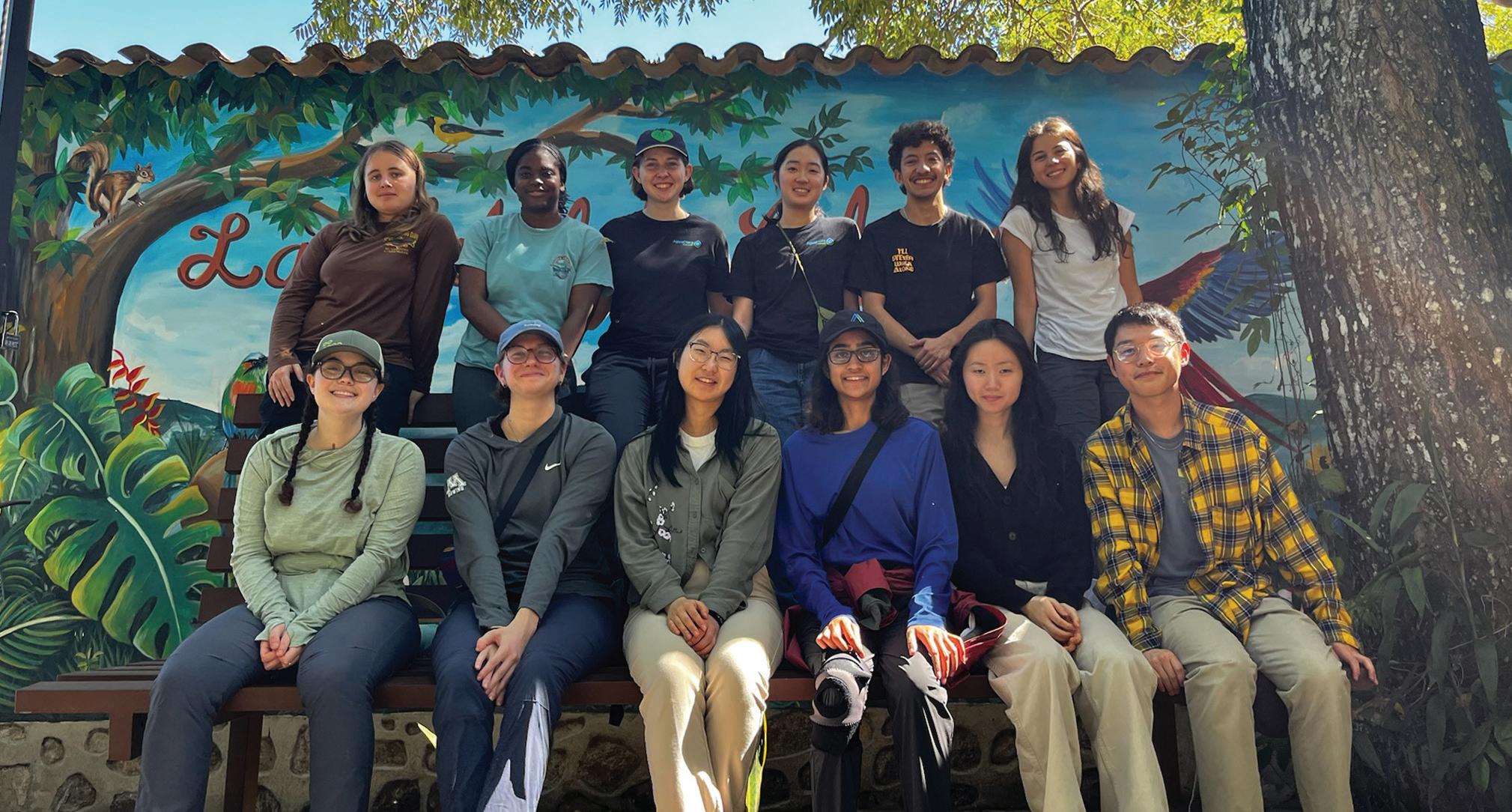
in a clarification tank, and what’s left is clean water that goes through a final filtration and chlorination step.”
The team’s latest research explores automated coagulant dosing control — a method that uses mathematical models to predict how dirty the incoming water is and adjusts the chemical dose accordingly.
Because the design avoids mechanical mixing, the plants use little to no electricity — a crucial advantage for rural areas without reliable power sources. “We’re trying to make water treatment that is simple and less likely to fail,” Wang said. “Our systems use locally sourced materials like concrete and PVC, so communities can easily replace parts when needed.”

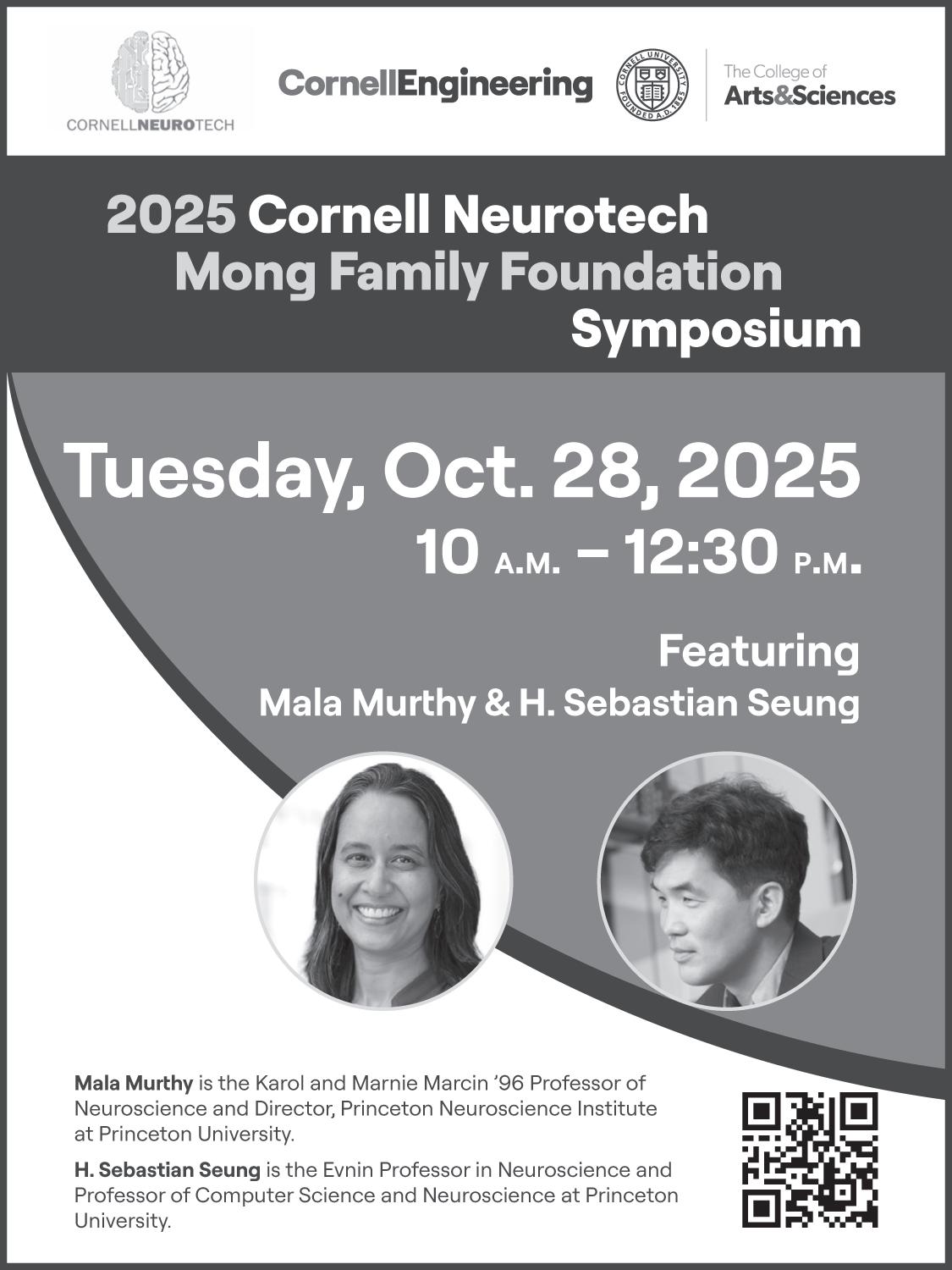
AguaClara’s approach also advances environmental sustainability. Without pumps or electric mixers, its carbon footprint is significantly lower than conventional treatment plants.
From the Lab to the Hillside
While most of AguaClara’s work takes place in Ithaca, each winter break a group travels to Honduras to see the plants firsthand and work directly with local operators. Team lead Kayla Stephenson ’26 joined the January 2025 trip and helped troubleshoot a plant in San Nicolás, Honduras.
“One of the plants had a blockage in its clarifier, and the community was struggling to remove it,” Stephenson said. “We went in, cleaned it out and helped them get the system running again.”
These trips are a cornerstone of AguaClara’s philosophy: empowering local communities through knowledge transfer. “We always train operators and use materials that are accessible to the community,” Stephenson explained. “The goal is for them to fully understand how the plant works so they can run the plant and fix any issues.”
That community-driven approach helps the systems last. Instead of outside engineers dropping in to install a plant and leaving, AguaClara’s local partners — such as Agua Para el Pueblo, a Honduran non-governmental organization — guide each project from design to long-term maintenance.
For communities that previously relied on untreated river water, the impact of AguaClara plants is profound. “When people don’t have access to clean drinking water, you see higher rates of stomach illnesses and diarrhea,” Wang said. “After an AguaClara plant is built, those rates go way down. People can stay healthy.”
According to Stephenson, access to clean water also relieves financial strain as families can drink from their own tap, instead of purchasing bottled water week after week.
Looking Forward
Though most AguaClara systems are currently in Central America, the Cornell team and its partner organization AguaClara Reach are exploring ways to spread their technology elsewhere.
“We’re hoping to expand into Puerto Rico through a collaboration with Prof. Ruth Richardson’s, [engineering], [WaterSAVerS] project, funded by the NSF [National Science Foundation],” Stephenson said. “It uses AguaClara’s treatment technology.”
According to Wang, the team also envisions adapting its prefabricated “pickup-truck” plants — small, portable treatment units — for use in rural parts of the U.S. These pickup-truck plants can be built ahead of time and driven to communities, meaning water treatment can begin immediately for communities lacking safe drinking water.
For both Wang and Stephenson, the project’s importance goes far beyond its engineering feats.
“Water is something everyone needs to live,” Stephenson said. “Two billion people still lack access to clean drinking water, and around two million [people] die every year from waterborne diseases. Our hope is to play a part in changing that.”
As AguaClara continues to innovate with gravity-powered technology, its mission remains clear — to make clean, affordable water a universal reality.
“Being part of AguaClara has been one of the most empowering parts of my Cornell experience,” Wang said. “It’s taught me that even as students, we can make a real difference.”
Marissa Gaut and Kitty Zhang can be reached at mgaut@cornellsun.com and az429@cornell.edu.


MARISSA GAUT and KITTY ZHANG Sun Science Editor and Sun Staff Writer
Purification power | AguaClara treatment plants use the power of gravity to deliver reliable and eco-friendly water treatment to communities with limited access to clean drinking water.
COURTESY OF CLAIRE WANG '27
Eco engineering | Cornell AguaClara visited Honduras in January to see their work and its local impact in person.
COURTESY OF CLAIRE WANG '27
The Corne¬ Daily Sun
Your Guide to North Campus Dorms
By Maya Rothbard
Maya Rothbard is a sophomore in the College of Arts and Sciences. She can be reached at msr295@cornell.edu.
Here it is — the review we’ve all been waiting for: a true glimpse into Cornell University’s freshman dorms on North Campus, told through experience rather than photos. You might be thinking, “It’s RBG or nothing!” But the truth is, freshmen don’t get to choose their dorm — you live where you’re placed.
As someone fresh out of their first year, I can offer some honest insight. I lived in both High Rise 5 and Low Rise 9, officially known as Just About Music Program House (JAM). While these names don’t carry the same clout as “Hu Shih” or “Ruth Bader Ginsburg,” I ended up loving both.
Starting with High Rise 5, I lived in a double that was spacious, carpeted and comfortable. You can live in singles, doubles or triples, and there’s plenty of room for belongings. The only downsides were the small desk and lack of air conditioning during warmer months. Still, I appreciated having keycard access to Jameson Hall next door, especially when visiting friends. The bathrooms are suite-style, the elevators reliable and the laundry room even had an ice machine and a clean water fountain. The dorm’s location is unbeatable — steps away from Robert Purcell Community Center (RPCC), where students grab late-night chicken tenders from Bear Necessities.

It’s also right by a TCAT bus stop. Route 30 goes to the Ithaca Mall while Route 81 loops around campus — convenient for avoiding icy sprints in winter. Overall, I had a great experience in High Rise 5. The only real flaw was the study lounges; the lighting was unpleasant and the space felt more social than studious. Still, the Sky Lounge on the sixth floor had great views and was perfect for hanging out. When I moved to JAM, a program house for musically inclined students, I absolutely loved it. I had a spacious single with high ceilings and hardwood floors — a major upgrade from High Rise 5. JAM residents tend to be more communal and outgoing, hosting socials, open mic nights and even “dog-petting” events in the lounge. Each suite has communal closets and the bathrooms are similar to those in the High Rises but with an extra curtain for privacy. Despite the name, it’s not noisy — music practice is confined to the soundproof rooms on the main floor. My only complaints: no ice machine, no elevators and a confusing layout. Still, I loved living there. It’s close to Appel Commons and North Star dining hall, which has some of the best food on campus.
Moving on to the other Low Rises, 6 and 7 aren’t program houses but 8 (Holland International Living Center, or HILC) and 10 (Ujamaa) are. HILC, an international dorm, lets residents stay over breaks and
fosters a globally minded community. Ujamaa focuses on Black culture and community, with a library and spaces for events. Unlike traditional dorms, program houses like JAM, HILC and Ujamaa house students of all years, not just freshmen. All the Low Rises have singles, doubles and triples, with suite-style bathrooms. Don’t believe the stereotypes — these dorms are just as comfortable as the newer ones. My time in the Low Rises was just as rewarding as any friend’s in RBG or Hu Shih.
Shifting over to Clara Dickson Hall, built in 1946, the dorm is one of the oldest on North Campus and exudes a cozy, almost Harry Potter–like charm. With four floors, multiple entrances and mazelike hallways, it’s massive but welcoming. Rooms are spacious and old-fashioned, and while the bathrooms are communal, they’re well maintained. The courtyard, complete with picnic tables, is perfect for studying or relaxing outside. Dickson is near Appel, Morrison and RPCC and even has three pianos for the musically inclined.
Just across from Dickson are Court/Kay/ Bauer (CKB) and Mews, which share nearly identical layouts. Both have singles and doubles on each floor with suite-style bathrooms, bright lounges and big windows. The bridge connecting CKB buildings offers one of the best photo spots on campus. CKB has carpeted floors while Mews doesn’t. Both are close to Helen Newman Hall — home to a gym, pool, basketball courts and even a bowling alley. I took a bowling class there for my PE requirement and loved it.
Next up is Mary Donlon Hall, known for being one of the most social dorms on campus. Built in 1961 and shaped like a fidget spinner, Donlon houses around 400 students. It features four-person suites with two double rooms separated by a shared living space — rare for freshman housing. The dorm also has a small library, large kitchens and circular hallways. The bathrooms are communal but well equipped. The only downside: no overhead lighting, so bring a lamp.
Just down the hill sits Balch Hall, Cornell’s iconic all-women dorm and one of the closest to Central Campus. Built in 1929 and renovated in 2024, Balch now houses about 470 residents in spacious singles and doubles — all air-conditioned with excellent closet space. Its location near Helen Newman and Appel makes it convenient for classes, dining and gym access. The building’s historic architecture and green lawn make it one of the most picturesque spots on North Campus.
Finally, the newest additions to North Campus — Ruth Bader Ginsburg, Hu Shih and McClintock Halls — are sleek, air-conditioned and nearly identical in design. Located steps from Appel and Helen Newman, they feature singles, doubles and quads (four people sharing one large room). The lounges are beautifully furnished with kitchens and whiteboards for group study sessions. Bathrooms are suite-style and far nicer than in older dorms. Hu Shih has a game room while RBG has Novick’s Café, a favorite study spot with great drinks and mobile ordering. No matter where you’re placed, you’ll find something to love. Each dorm on North Campus has its own charm — whether it’s JAM’s creative energy, Dickson’s historic coziness, Donlon’s social buzz or RBG’s modern design. Wherever you end up, you’ll make it your own.


Refecting on My Fall Break Escape to California
By Jeanelle Wu
Jeanelle Wu is a sophomore in the Dyson School of Applied Economics and Management. She can be reached at jkw98@cornell.edu.
Welcome back from fall break! Did you miss school? I sure didn’t.
I was too busy eating like King Henry VIII and migrating as if I was living through Westward expansion (I returned home to California). Oct. 9 through 14 was not just fall break for me — it was a mission and I was Tom Cruise. My assignment? To escape from Ithaca and bask in doing all the things I can’t do here at Cornell. I think I did pretty well, but you could be the final judge of that.
Thursday
Since my professors were thoughtful enough to cancel my two classes on Friday, my fall break started a bit early. Every day counts when you live across the country and are trying to squeeze the most value out of your long distance journey. Having packed my carry-on suitcase the night before, I was ready to go to the airport after my two morning classes on Thursday. Being the responsible student I am, I had reserved an Uber to take me to Syracuse airport at noon for my 3:22 p.m. flight.
Before I knew it, I was on a small plane to Philadelphia. An hour and 15 minutes later, I was fighting for my life trying to make my connecting flight. During the 5 hour and 45 minute flight from Philadelphia to Los Angeles, I watched two episodes of “Love is Blind,” three episodes of “Friends” and ate an overpriced burrito bowl.
My dad picking me up from the airport and us getting In-and-Out on the way back home was the highlight of the long journey. I cannot stress how much I was looking forward to the iconic cheeseburger, fries and chocolate milkshake. As someone who grew up in Southern California, In-and-Out is the epitome of fast food and a solid burger. That meal was a reward for my long travels and filled my stomach with nostalgia.
Friday
After having homemade chicken soup for breakfast (what I begged my dad to make for me), I drove one and a half hours from my house to San Diego. I forgot how much I loved to drive. Driving down the coast with the ocean to my right and my favorite music surrounding me in the car was incredibly peaceful (another thing I can’t do in Ithaca). Once I picked up my boyfriend from UC San Diego, we headed to my favorite restaurant: Din Tai Fung. Since there are only select locations in major cities, I have been having Din Tai Fung withdrawals. Knowing exactly what I wanted to order before sitting down, I devoured their pork xiao long bao, spicy shrimp and pork wontons, kale with garlic, braised beef noodle soup, passion fruit green tea with boba and taro xiao long bao with sea salt cream for dessert. Delicious is an understatement. I wanted to be full enough to last till the next time I could go back.
Next up was shopping. Although Ithaca has cute stores here and there, it is definitely lacking in department stores and clothing chains. So, at Westfield UTC, an outdoor shopping center in La Jolla, I hit all my favorite stores including Aritzia, Hollister, Pacsun and Garage. I didn’t go too crazy and ended up walking out with a cute butter-yellow sweater and black puffer.
I think the best part of Southern California is the beaches, so it would be criminal not to take a walk on the shore. I looked out to the coastline to see people surfing, adventurers paragliding and birds chirping. I lost track of time staring at and listening to the waves; I wanted to absorb the view and beachy weather for as long as I could.
For dinner, some friends from high school and I went to get Shake Shack. (Yes, burgers again. Don’t judge me.) I got a SmokeShack burger, parmesan fries and a strawberry lem-
onade to wash it all down. I knew Shake Shack originated in New York, so I was disappointed when discovering there is no Shake Shack in Ithaca. After hanging out with my friends for a few hours, I headed back home — doing carpool karaoke with my friends in the car — at around 11:30 p.m.
Saturday
Tired from the long day I had on Friday, I allowed myself to sleep in until noon — a luxury I appreciate as someone with 8:40 a.m. classes. Three of my friends from home and I went to the Wingstop in our town, and I got the hot honey chicken tenders with lemon pepper fries and a Dr. Pepper. I know this isn’t exactly the healthiest meal, but I think it is fine considering it is a break from dining hall foods. Overall, it was a chill day. We went to buy Pokemon cards and blind boxes (I personally don’t gamble with these but I support my friends who do). After they opened the cards and boxes and realized they wasted their money, we played some friendly games of mahjong to continue testing our luck. Then, I picked my mom up from the airport and drove to a Korean restaurant called Young Dong Tofu House.
Sunday
Waking up on Sunday I had an urge to make something. Driving to Whole Foods, I picked up ingredients to make soft, chewy chocolate chip cookies from scratch, along with salad and steak to make it a complete meal. An hour in the kitchen later, my boyfriend had cooked two ribeyes to perfection, and my chocolate chip cookies were in the oven. There’s nothing like a home cooked meal and freshly baked cookies to feel at home.
I then decided to take advantage of the sunny weather by swimming in the pool. Jealous? Only in California is it warm enough outside to jump into a pool in the middle of October. In the evening, my sister came over, and I spent the rest of the day playing games and goofing around with two of my nephews.
Monday
A not so fun part of my day was going to the dentist at noon. Luckily, I had no cavities and left with a clean set of teeth, so I guess it wasn’t that bad. Then, my mom and I had a girls’ spa day where we went to get massages and relax at the spa. Feeling refreshed and tension-free, we headed to the mall where we walked around and ate cinnamon pretzel bites.
For dinner, I dressed up to go out to a nice family dinner at a restaurant called Farmhouse at Roger’s Garden. Not only was the short rib entree and chocolate truffle cake I ate amazing, but the atmosphere of the restaurant was calming and joyful. I spent hours catching up with my family and coloring with my other nephew and niece.
Tuesday
My journey back to Ithaca started with driving to Los Angeles Airport for my 1:00 p.m. flight. On my five hour flight from LA to Washington, D.C., I watched five episodes of “Pop Star Academy: KATSEYE” and ate a Cinnabon I had bought before the flight. I had a one and a half hour layover in Washington, D.C. and arrived in Ithaca at around 12:30 a.m. Getting back to my dorm around 1:00 a.m., I was exhausted but fulfilled from my trip. Clearly, I ate a lot of good food, caught up on sleep and kept myself busy throughout the break,but quality time with my family and friends undoubtedly takes the trophy for best part. The hours spent on planes and in airports was worth being able to escape from Ithaca to do things I haven’t been able to do, even if it was just for a few days.
MAIA MEHRING / LIFESTYLE EDITOR
Navy Veteran, Mother, Rebecca Bennett ’09 Runs for Congress in New Jersey’s 7th District
By ATTICUS JOHNSON
Senior Writer
Oct. 21 — A Navy veteran and healthcare professional Rebecca Bennett ’09 is vying to be part of a new wave of “strong leaders” elected to Congress in 2026, she told The Sun.
Bennett joins Democrat Megan O’Rourke P.h.D. ’09 in the race. Both of the two former Cornellians are running with a focus on affordability and healthcare, though Bennett says she is the best candidate to win a competitive district.
The Bridgewater native said she decided to enter the Democratic primary for New Jersey’s 7th district because of her past military service to the country.
“I felt this calling to lean in, because I love this country and want to fight for the version we want to live in and leave for my daughters,” Bennett said.
Since announcing her campaign on Feb. 4, she has raised more than $1.3 million — the most among the nine Democrats running to unseat incumbent Thomas Kean Jr. (R-N.J.)
The purple 7th district is New Jersey’s most competitive and is on the Democratic Congressional Campaign Committee’s target list, which sets Democrats’ priorities for the upcoming midterms. Kean only won New Jersey’s 7th district in 2022 with a two percent margin.
With so many candidates running, Bennett says she will not only run on her electability, but on “getting things done” once in Congress.
“I have a unique set of experiences: I served in the United States Navy in some of the most challenging environments on planet earth,” Bennett said, adding that Democrats are “craving leadership” during President Trump’s second term.
Only one week after graduating Cornell, Bennett was at a Navy training camp in Florida. In the armed forces, Bennett served as a test pilot, aircraft commander and is now part of the Air National Guard.
After retiring from active duty in 2019, she earned her Masters in Business Administration from the University of Pennsylvania Wharton School and subsequently worked at healthcare companies Midi Health, which focuses on menopausal health, and Oshi Health, which specializes in gastrointestinal care.
Though Bennett believes there must be an effort to “prevent the worst cuts to Medicaid and Medicare,” that Trump has made, she also said that Democrats running in a competitive district need to focus on a proactive approach to healthcare, and that she believes in making the system “more efficient and effective.”
She also said healthcare was one of the three most important issues in the midterms, which also include affordability and national security.
As a mom of two kids, Bennett argued that
her family sees “firsthand the effects of the economy.”
On national security, the former navy pilot said that she would focus on “supporting peace” and “promoting democracy throughout the world,” with a focus on “preparing the United States for 21st century warfare,” according to her website.
Bennett is pro-Israel and said she “supports the state’s right to exist and defend itself,” after being asked how she sees her pro-Israel stance in a Democratic party that is rapidly shifting away
from Israel. However, when asked about taking money from the American-Israeli Public Affairs Committee in the future — a growing concern among Democratic primary voters — Bennett’s aide requested to move on to the next question.
To continue reading this article, please visit www.cornellsun.com.

By EMMA GALGANO
Senior Writer
Student Assembly VP of Finance Reassesses Multicultural Funding Cuts Assembly Proposes Signs to Discourage Blocking Accessibility Ramps
Oct. 21 — The Student Assembly voted to reject the Student Assembly Finance Committee’s recommendation to reduce funding for the ALANA Intercultural Board, the Multicultural Greek & Fraternal Council and the International Students Association at their Oct. 9 meeting. In the aftermath, Vice President of Finance Hayden Watkins ’28 explained how the committee arrived at its proposals and what comes next in an interview with The Sun.
For the 2025-2026 academic year, ALANA — a student organization that promotes diversity and intercultural understanding while providing supplementary funding to 138 student organizations — received $14 per student. The board requested $16 per student for 2026-2028, but the Finance Committee initially recommended just $9.90, based on estimates of ALANA’s total budget and the assumption that many of its affiliated organizations could receive support through the Student Activities Funding Commission, according to Watkins.
Watkins said the committee believed many of ALANA’s affiliated groups could be funded through SAFC rather than ALANA directly, based on the information that 66 organizations had SAFC funding.
After further review, the committee found that nearly all of ALANA’s affiliated organizations — except for a group of organizations deemed ‘The Big Five’ by Watkins — already receive SAFC support. ‘The Big Five’ — Black Students United, La Asociación Latina, Cornell Asian Pacific Student Union, Native American and Indigenous Students at Cornell and South Asian Council — are funded directly through ALANA and cannot receive SAFC funding. Recognizing this, the committee acknowledged it needed to reassess its recommendation.
During the meeting, Afsheen Alvi ’26, co-president of ALANA, expressed disagreement towards the funding recommendations.
“Cornell cannot be world-class if it is not open to the world, and being open to the world means supporting every student across it who trusts Cornell to protect them.” Alvi said. “This begins at the very initial level of supporting our programming
and our attempts to share internationalism with Cornell’s campus.”
The Student Assembly’s funding process begins, early in the semester, with byline organizations submitting applications and meeting with the finance committee to present their budgets and answer questions. After these sessions, the committee deliberates and votes on funding levels, with recommendations later sent to the full assembly for approval.
When it comes to calculating the exact dollar amounts for funding recommendations, Hayden stated there is not a strict formula, noting that there is a mix of both methodology and judgement.
Ahead of the Assembly meeting, ‘The Big Five’ encouraged students to “Pack the Vote for ALANA” on Instagram, drawing roughly 130 attendees.
Watkins reflected on the student response, saying, “If I was in the position of a lot of these students, I probably would have responded the exact same.”
To continue reading this article, please visit www. cornellsun.com.
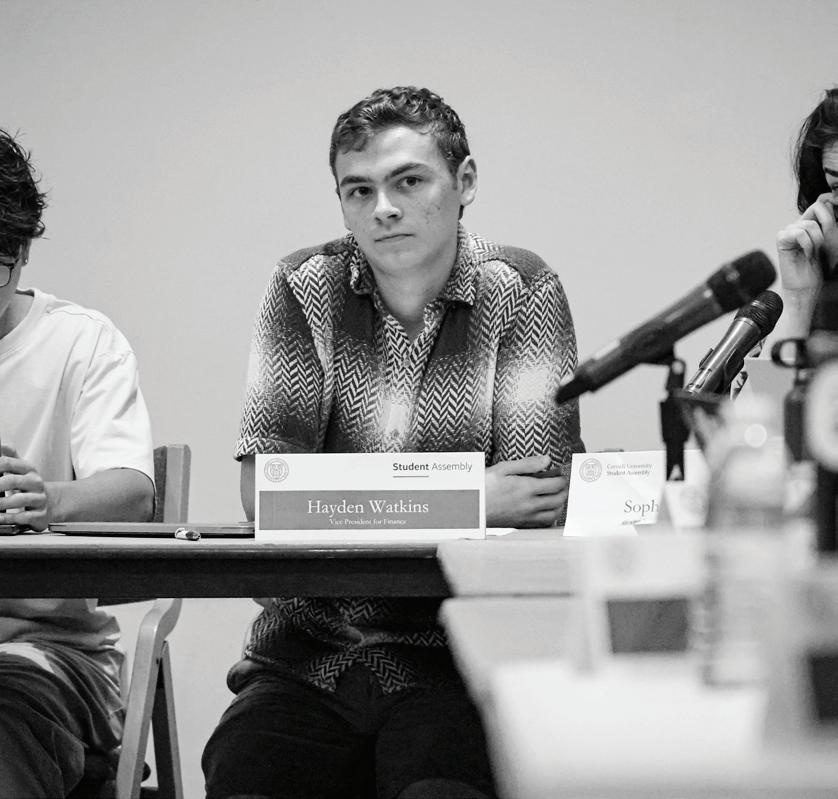
Oct. 18 — The Student Assembly unanimously voted to pass Resolution 11: Addressing Obstructed Ramps and Handicap Aisles on Campus during Thursday’s meeting. The resolution reaffirms the illegality of obstructing handicap aisles and ramps on campus and recommends that Facilities and Campus Services place signs which expressly prohibits obstructing these areas with bikes or e-scooters, per the resolution’s abstract.
Hayden Spector ’26, students with disabilities representative, and Dylan Carson ’28, College of Arts & Sciences representative, co-authored the resolution.
It is illegal in New York State to block accessibility ramps and aisles, and community members can contact the Cornell University Police Department to remove any obstructions. However, “students are hesitant to do so because it requires additional time and resources,” according to Resolution 11.
“A lot of students don’t think [accessibility obstruction] is a problem,” Spector said, adding that Resolution 11 aims to prevent accessibility issues rather than retroactively solve them.
“It is actually illegal to block walkways, and students can in fact call the police to be able to cut the bikes off,” said Spector, adding “it took 30 minutes for a police officer to come and help out” when she reported an obstruction in the past.
“[Calling the police is] not really even an immediate solution for people with disabilities. So, this [resolution] is trying to prevent it from happening in the first place,” said Spector.
Christian Tarala ’27, School of Hotel Administration representative, said Resolution 11 does not suggest “disincentives” to discourage people from blocking accessibility measures on campus.
“The disincentive is that you can be fined and have your bike lock cut off,” said Spector. There are “recommendations” to reiterate the illegality of obstructing pathways, which the resolution states is not “universally known by students.” Resolution 11 passed without dissent or abstention by assembly members and is now subject to approval by University Administration.
Sun
Sun
Congressional campaign | Rebecca Bennett ’09, a healthcare professional, is running to unseat incumbent Thomas Kean Jr. (R-N.J.) in New Jersey’s 7th Congressional District.
COURTESY OF REBECCA BENNETT ’09
Atticus Johnson can be reached at ajohnson@ cornellsun.com.
Finance feedback | Hayden Watkins ’09, Student Assembly vice president of finance, addresses funding cuts for multicultural groups on campus.
BENJAMIN LEYNSE / SUN NEWS EDITOR
By EMMA SPINDLER Sun Staff Writer
Emma Spindler can be reached at es2272@cornell.edu.
Emma Galgano can be reached at egalgano@cornellsun.com.




Luke Robinson Represents Team Canada for Lacrosse Championship
By WILLIAM D. CAWLEY Sun Staff Writer
Oct. 19 — This summer, sophomore midfielder Luke Robinson realized his lifelong dream by representing Team Canada as he helped lead the team to the men’s lacrosse U20 world championship.
In Canada, the lacrosse experience is not what an American might expect, with just a few months of field lacrosse per year, and a whole lot of box lacrosse.
Box lacrosse takes place in an ice hockey rink with the ice removed. There are six players per team (compared to the 10 for field lacrosse) and no long poles. The goalies wear pads similar to hockey goalies and are much less mobile than field lacrosse goalies.
“You don’t get a lot of that field experience that I feel like the Americans get. … They drill box [lacrosse] in you pretty hard,” Robinson said.
Because of this, Canadians in lacrosse often have a reputation of being shifty, two handed ball movers, similar to the style of play that Canadian attackman Jeff Teat ’21 brought to Cornell. Despite all of his box experience, Robinson breaks this stereotype with his “speedy, dominant left hand” playstyle.
Even though the Canadian lacrosse experience is different than in America, the lacrosse community remains a small world. Robinson looked up to Cornell lacrosse alum and Canadian Dan Lintner ’14, who strung his first ever lacrosse stick.
Of course, Robinson would end up attending Lintner’s alma mater.
“I think it’s kind of funny how it worked out that way,” Robinson said.
Lintner scored 88 goals in his four years playing for the Red. Afterwards, Lintner went on to have a very successful professional career, with the Canadian playing box lacrosse in the National Lacrosse League. Former teammate of Lintner and Cornell head coach Connor Buczek ’15 MBA ’17 said “[Dan Lintner is] just a great competitor, great player and a guy that we’re fortunate to call a part of the Big Red family.”
Although he had long hoped to play for team Canada, Robinson could not think about it until he was officially on the team. “Once I was fortunate enough to get the call to make the team that’s probably the point [that I realized it was possible],” Robinson said.
Robinson first attended camp in Oshawa, Ontario before the team traveled to Jeju Island, South Korea for the tournament. Being previously played in Limerick, Ireland; Turku, Finland; and Adelaide, Australia, the tournament is a way to bring lacrosse to new places and grow the game.
“It’s exciting to share the game and hopefully make it more mainstream, not just in North America but abroad too,” Buczek said.
Canada opened its campaign against the United States, which had Buczek on the coaching staff, running the American offense. The U.S. roster included freshman attackman Rowyn Nurry and sophomore defenseman Michael Marshall.
In this opener, Canada fell 7-6, but Robinson tallied a goal and an
assist. Despite the loss, Robinson felt the pride of representing his country.
“It’s the highest honor to be able to wear the colors and represent your country,” added Buczek, a former team USA player.
Canada went on to dominate its next four games, beating Australia, Haudenosaunee, Jamaica and Australia again to set up a rematch against the United States in the final. In the high powered grudge match, Canada overcame the odds and won the world championship by a score of 6-5. “Their team is very talented and they were favored to win the game, we knew it was going to be a battle. It was pretty sweet to come out on the winning side of it,” Robinson said.
With Cornell in 2025, Robinson did not see much playing time, with a stacked roster of upperclassmen in front of him.
“Last year with Cornell we had so many great players. I took more of a backseat role and tried to learn from those guys,” Robinson said.
Now, Robinson will likely step into a bigger role in the Cornell midfield that graduates many key contributors, including Canadian Andrew Dalton ’25. Of Robinson’s role this spring, Buczek said, “Playing high level lacrosse as much as he did this summer with team Canada put him on a good trajectory to come back and be ready to take a bigger role. … If this team is going to be successful he is going to play a big hand in that.”
Robinson has simple individual goals for the season, to fit the Cornell system and do whatever it takes to get the team a win.
It is a packed offseason schedule for the Red, who value strength, conditioning, and team building as much as any team in the country. “We get workouts four days a week, so it’s busy but that’s what makes it so good. Coach Howley is one of the greatest, he knows what he’s doing, so whatever he tells us to do we’re going to do it,” Robinson said.
“We’re fortunate to have the best strength coach in the world working with our team,” Buczek said.
In the coming weeks, Cornell will be preparing for its “fall ball” offseason scrimmage against the University of Maryland, a national championship rematch. The two teams will face off in Wilmington Delaware at Salesianum high school on Oct. 25th at 1 p.m..
As always, Cornell has lofty goals for the 2026 season, according to Buczek.
“Goals are the same year in and year out. We want to win an Ivy League regular season championship, we want to win an Ivy League tournament championship, and we want to win a national championship,” Buczek said.
Despite the busy schedule, Robinson joked that while he is not ribbing Buczek as much, he is still finding time to let his teammates Nurry and Marshall from team USA hear about his win.
“[Robinson is] a superb young man, really excited for the success he’s had and excited to see what it looks like with the Big Red this Spring,” Buczek said.
William D. Cawley can be reached at wcawley@cornellsun.com.

Ithaca Crossword Competition Held This Past Weekend
By HUSSAM KHER BEK Sun Staff Writer
The Finger Lakes Crossword Competition returned to Boynton Middle School for its 13th year on Saturday, Oct. 18. The event’s proceeds went to supporting adult literacy in the county.
The competition consisted of one 60 minute round with doors opened at 1 p.m. and the competition was set to begin at 2 p.m. Winners were announced at 3:15 p.m., according to the competition’s website.
Prizes included “priceless bragging rights,” a copy of Merl Reagle’s Sunday Crosswords and personalized Perfect Puzzle Certificates for all in-person players who complete a perfect puzzle within the competition time period
Gary Weissbrot ’71, TLP board member and Finger Lakes Crossword Competition chairperson, spoke about the event’s tenacity.
“We had 2 years where [the competition] was held virtually for 2 years, but we never missed a year.”
Gary Weissbrot ’71
“We had 2 years where [the competition] was held virtually for 2 years, but we never missed a year,” Weissbrot said. The event usually has between 100 and 120 people, according to Weissbrot.
The competition featured crossword puzzles in the New York Times’ “daily” style. To accommodate each participant, the competition provided three levels of difficulty using The Times’ system of incremental increases in difficulty throughout the week. These levels range from easiest, published on Mondays and Tuesdays, to trickier, published on Wednesdays, to toughest, published on Thursdays.
All proceeds went to Tompkins Learning Partners, an organization that supports adult literacy in Tompkins County. TLP has provided one-on-one tutoring for local adults for 50 years. Tutoring is offered in English language learning, adult basic education — including studying for the GED — and preparation for the US citizenship interview.
The competition had an entry fee consisting of a suggested amount of $50 per player. However, the competition has a “Pay what you can comfortably afford” policy to ensure everyone can participate, according to the competition’s website.
Weissbrot highlighted the openness of this event, pointing to the unique team format and the virtual option.
Players can choose to participate individually or as part of a two, three or four player team where team members will compete against each other, according to the Fingerlakes Crossword Competition website. The competition is also open virtually, so players can solve puzzles from anywhere around the world and compare their times with the in-person winners.
“We have a local, world-class puzzle constructor. His name is Adam Perl, and he makes all of our puzzles. He’s been published [in] many places, including the New York Times.”
Gary Weissbrot ’71
Weissbrot also emphasized the local efforts in making this event possible, citing Ithacan and antique shop owner Adam Perl and Cornell’s Alpha Pi Omega as some of the main contributors.
“We have a local, world-class puzzle constructor. His name is Adam Perl, and he makes all of our puzzles. He’s been published [in] many places, including the New York Times,” Weissbrot said. “Because everybody is being timed, we have monitors. All of our monitors are volunteers from Cornell’s service fraternity APO.”
Steven Schapiro, New York licensed real estate broker and president of Cayuga Sunset Properties Management, has sponsored the event since its inception. In an email sent to The Sun, Schapiro emphasized the importance of the event for the community.
“CSP Management has been a sponsor of the Finglerlakes Crossword Competition since its inception, so this will be our 13th year,” Schapiro said. “It is a fun event which has been a joy to partake in each year. Tompkins Learning Partners, the host and beneficiary of the event, is a local not-for-profit organization whose mission is admirable.”
In an email sent to The Sun, Donna Ramos, executive director of TLP, praised the event and noted the importance of local residents, event participants and sponsors in supporting TLP’s mission. She also encouraged Ithacans to attend.
“This event is a great way to spend a fall afternoon, participating as an individual or team member at one of three competition levels — supporting local adults at the same time,” Ramos said.
Husssam Kher Bek can be reached at hkherbek@cornellsun.com
Grid games | The 60 minute long crossword competition took place at Boynton Middle School began 2 p.m. on Oct. 18.
BENJAMIN LEYNSE / SUN NEWS EDITOR

Brianne Jenner ’15, Jill Saulnier ’15
Honored for Hall of Fame Induction
By JANE McNALLY Sun Senior Editor
Oct. 18 — Outside the women’s hockey locker room after a 4-2 win over Boston College — completing an opening weekend sweep — the smiles and laughter were uncontainable.
It was alumni weekend for the Cornell women’s hockey program, which meant dozens of former skaters were back in Ithaca to watch the 2025-2026 team. It was almost as if being back in Ithaca transported the alumna back to their time on the Hill, the energy palpable as former teammates rehashed old memories and visited their favorite spots on campus.
For Brianne Jenner ’15 — who, since her time at Cornell, has won two Olympic medals for Team Canada — this weekend meant a little bit more. Jenner and Jill Saulnier ’15 were honored after Saturday’s game for their inductions into the Cornell Athletics Hall of Fame.
“It was a huge honor,” Jenner told The Sun. “I think getting that phone call [brought back] so many amazing memories from my time here. I feel like [Cornell] kind of made me the athlete I am today and the person I am today.”
Jenner, now captain of the Ottawa Charge in the Professional Women’s Hockey League, posted 229 points as a Cornellian from 2010-2015, a number that tops the Cornell women’s hockey record books.
“So many of my great memories happened in the dressing room here with the girls. We had such a great group, and I think that’s what I think of.”
Brianne Jenner ’15
Her time at Cornell — much like all the other alumna that returned for the celebratory October weekend — means a whole lot more than that.
“So many of my great memories happened in the dressing room here with the girls,” Jenner said. “We had such a great group, and I think that’s what I think of. I think of the times on the bus, in the dressing room, and just all the fun that we had together.”
Jenner and Saulnier united on the Lynah Rink ice with their families, another step of their hockey journey that they will share together. The pair have been teammates since even before they shared the ice at Cornell, winning silver at the IIHF Under-18 World Championships in 2009.
When Jenner took off the 2013-2014 collegiate season to play in the 2014 Winter Olympics, that reclassed her into Saulnier’s grade for the 2014-2015 season. The two, often playing on a line together, put up a combined 95 points, with Saulnier leading the way with 20 goals.
“Jilly is a really special teammate. She just puts a smile on your face when you’re around her,” Jenner said. “Girls love to be her teammate, love to be around her, and she was a dynamic, offensive, fast player. When she was on the ice, she always kind of swung the momentum for the Big Red. … I think she’s just unbelievable and very deserving of this honor.”
Saulnier and Jenner now compete against each other in the PWHL, as Saulnier suits up for the Boston Fleet. The two are tasked with rigorous training schedules and the strict regimen of professional hockey — but, like many others, still find the time to make the trek back up to a place they love.
“It’s been really fun. A couple close friends from my class were back here to be here with us, and a lot of the young alumni here too,” Jenner said. “It was just special to be in the rink today and see the girls play an awesome game, twowin weekend. Just kind of being around campus, hitting up some of our favorite old spots, showing the kids.”
The festivities didn’t stop — or begin — with Saulnier’s and Jenner’s inductions. Many of the young alumni were from last year’s Ivy League championship, ECAC championship and NCAA semifinalist squad, and were back in town to reveal their three banners that will soon hang in the rafters at Lynah Rink.
Returning players from last year’s team were positioned at each banner and unveiled them prior to puck drop. While Jenner — like Cornell’s Class of 2025 — played in the Frozen Four during her time with the Red, her outlook following her Cornell career was much different. At the time, the PWHL didn’t exist, and women’s hockey had yet to establish a sustainable professional league.
While Jenner and Saulnier have both played international hockey at the highest level, Jenner noticed subtle
differences when watching the 2025-2026 Cornell team this weekend.
“The PWHL has changed our entire sport. Watching this game today, the talent level, the speed — it’s definitely just getting better and better each year, and that was really great hockey to watch today,” Jenner said after Cornell’s 4-2 win over Boston College. “I always felt, prior to that league, that [the time] I was treated most professionally — outside of the Olympic team — were my four years here.
“The PWHL has changed our entire sport. Watching this game today, the talent level, the speed — it’s definitely just getting better and better each year, and that was really great hockey to watch today.”
Brianne Jenner ’15
“That’s when you had the most support, the most fans, the investment all around. It’s just really exciting to see that that’s not going to end now for great players coming out of college. They have that opportunity to develop even more and [it’s] just going to elevate the whole sport. You already see it over here. It’s just an unbelievable level of hockey.”
The student-athlete experience at Cornell — evident through all of the wide grins and laughter echoing throughout the halls at Lynah Rink — is unlike any other.
Perhaps that’s why everyone keeps on coming back, no matter if they’re still lacing up the skates and no matter where they’re coming from. Whether or not players have shared the same ice, the locker room is always open.
“I wanted to go to a school that was going to challenge me in my development. And I learned pretty quickly when I came to Cornell that I was going to get that,” Jenner said. “I feel like the hockey program — there’s a level of work ethic that you need to fit in here with the Big Red, and I think that’s something that I took with me and kind of really shaped me. … It was such a challenging and amazing education. I really enjoyed that whole experience. I grew a lot.”
Jane McNally can be reached at jmcnally@cornellsun.com.

Ice legends | Saturday concluded women’s hockey’s alumni weekend, culminating in the celebration of Brianne Jenner and Jill Saulnier.
GRADY MILLONES / SUN PHOTOGRAPHY CONTRIBUTOR
Historic pair | Saulnier’s and Jenner’s families joined them on the ice postgame to celebrate their Cornell Athletics Hall of Fame inductions.
Tame Impala: Disappointment on Deadbeat
MATTHEW RENTEZELAS ARTS & CULTURE WRITER
“Did you know Tame Impala is just one guy?” This question has been asked by countless indieheads hoping to impress others with their musical knowledge, so much so that it has become a popular meme. The question also emphasizes the sheer talent of Kevin Parker, the sole member of Tame Impala: How could “just one guy” play so many different instruments and produce such rich songs? Unfortunately, however, Parker failed to imbue Tame Impala’s newest release with the sort of awe-inspiring quality associated with his past work.
Deadbeat, released on Oct. 17, is Tame Impala’s fifth studio album. The release was highly anticipated by fans, as it has been over five years since the release of Tame Impala’s last album, The Slow Rush, in 2020. Deadbeat marks a creative departure from Parker’s previous work, which was made clear after the release of the singles “Dracula,” “Loser” and “End of Summer” in the weeks leading up to the album’s debut. Though Parker manages to create a few praise-worthy tracks, the album’s overall sound largely comes off as uninteresting and uninspired.
The opening track, “My Old Ways,” starts off with a simple combination of Parker’s vocals and a repeating piano riff. At the one-minute mark, bass, drums and effects join the mix, building nicely on the original idea. The song continues to ramp up in a very satisfying way, delivering a powerful and driving beat that builds momentum and excitement for the rest of the
album. Unfortunately, this momentum is killed immediately upon playing the next track. In “No Reply,” Parker delivers painfully uninteresting vocals that he seems to be bored singing. The poor vocals are made worse by comically bad lyrics. When I heard the line “you’re a cinephile, I watch Family Guy,” I genuinely started to laugh out loud at the poor lyrical work on display.
“Dracula” easily stands as one of the best tracks on the album, and helped to revive my hopes for the album after “No Reply.” The song has an addicting feel because of its exceptionally groovy bass and drum parts. Parker also uses a number of musical phrases reminiscent of a retro horror vibe, adding to the fun of listening.
The album provides another drop in the quality with “Loser,” which has consistently bland and uninteresting instrumentation that does not build or go anywhere. Parker’s basic vocals are not strong enough to rescue the track from mediocrity, and the overall sound leaves you desperate to move on to something with more to say. “Oblivion” fails to impress in similar ways. Though the track ramps up in a few sections, these moments are ultimately unsatisfying until the very end of the song.
The repeating beat in “Not My World” becomes quite irritating after a while, not offering much depth at all in the way of sound or quality. The buildup and drop are a welcome change after having to spend almost three minutes listening to the same annoying motif. However, even the section after the drop becomes boring quite quickly, seeming like something
created by an amateur DJ rather than an established artist. “Piece of Heaven” stands as one of the more creative tracks on the album, featuring unique synth parts and more impressive layering than many of the others. Parker creates a much more enjoyable balance between higher and lower energy moments on the album, resulting in a truly pleasant track.
“Obsolete” sees a continuation of more rich production and layering, with rich drum and bass parts and a beautiful display of Parker’s signature usage of synths. Parker’s vocals also command greater attention in “Obsolete” as compared to many of his more basic vocal additions in other tracks. “Ethereal Connection” has moments of greatness, but these moments don’t seem strong enough to keep the listener’s attention for the seven minute and 42 second runtime. Though not an outright poor display of Parker’s talents, the song is nothing to write home about.
“See You On Monday (You’re Lost)” somehow manages to feature all of the album’s major weaknesses. Its instrumentation is flat, uninteresting and repetitive; Parker’s vocals share these same characteristics. The song goes nowhere, and does nothing to excite or impress, instead leaving the listener in a state of annoyance and boredom.
Thankfully, “Afterthought” and “End of Summer” are much easier to get through. “Afterthought” features a catchy beat and an engaging vocal performance from Parker. The synth and bass parts are well thought out and provide a great listening experience. “End of Summer,” another seven minute long track, features compelling

synth parts reminiscent of the Stranger Things score and a simple, but engaging beat. These elements help make the song much more enjoyable throughout its long runtime as compared to “Ethereal Connection.” After a number of missteps, Parker manages to end the album with an enjoyable song worth listening to.
Though Parker managed to create moments of quality throughout Deadbeat, much of the album is characterized by dullness and senseless repetition. The album easily stands as Tame Impala’s worst, a steep drop in quality compared to his previous work. I admire Parker’s attempts to craft a new sound and style throughout Deadbeat, but he fails to do so in a compelling way and I do not believe I will be returning to the album any time soon apart from a few of its highlights.
Diane Keaton: A Generational Talent
Oscar-winning actress Diane Keaton died at age 79 this past week on Oct. 11. Since the news, many collaborators and friends have issued statements on the positive impact she made through her life. She wore many hats: she influenced fashion from the ’70s onward in her adoption of men’s vintage clothing; she was a photographer who released piquant mixed-media pieces; she adopted and raised two children; and of course will be canonized most of all for the indelible impact she has left on film.
With over 70 acting credits and a career spanning six decades, Keaton was a major force in the industry. She appeared in the Godfather films as Kay Adams-Corleone, Michael’s wife, and in 1977 she won an Oscar for her performance as the titular character in Annie Hall. It is perhaps her role in this film, which was written as a semi-biography of her from Woody Allen’s perspective based on their real relationship (Keaton’s real last name is Hall), that best typifies what she uniquely brought to cinema. The character Annie Hall essentially is her.
In Annie Hall, she brings to the screen a new archetype, a kind of modern woman that hadn’t been represented before, or at least not widely. Her personality is a complicated mix of self-deprecation and nervous tics while at the same time being brazenly maverick and genuine. Many film critics have written about her performance, and to borrow some particularly memorable and apt descriptors, she is “the golden shiksa from the provinces who looks cool and together… but has only to open her mouth,” to reveal herself as “a social bungler,” “speaking in endearing little whirlwinds of semi-logic,” and in the words of Allen, “a nervous breakdown in slow motion.” She is intensely relat-
able. She speaks what most would keep as inner monologues out loud, “oh boy what a dumb thing to say… what a jerk…,” upon their first meeting, beaming at Allen in the hope this will void the need to say something (and probably saying the wrong thing). She is so resonantly awkward. She drives fast, comically swerving around obstacles by an inch, and when opportunity in the form of a producer funnily played by Paul Simon comes, she doesn’t balk but takes it head on, travelling across the country despite Allen’s protests.
She, as in real life forms liaisons with men (Woody Allen and Warren Beatty) similarly poised in the arts and imbibes from them a helping cultivation of her own aesthetic tastes, but it feels as if just as soon as she meets them, she springs off in a new direction propelled by her own edifying impulse. She isn’t fettered when she senses something on the horizon, but she takes and develops upon the good of every relation while it lasts. There is a vulnerable admittance of the intermingling between the identity of the partner and the self in Annie Hall. After they’ve broken up, Allen happens to see her going to a play he had recommended. And it’s an earnest reflection on how we inform our identity from the relationships we’ve had, but at the same time become more and more ourselves. When he meets her afterward, she’s still marching to her own wild tune, sparking along as if all the arbitrary turns of life had been her idea from the start, which I feel we all tend to believe.
Outside of Annie Hall, Keaton tackled many roles: her self-professed favorite, Something’s Gotta Give alongside Jack Nicholson (for which she received a fourth Oscar nomination and won a Golden Globe), a string of collaborations with Woody Allen in Love and Death and Manhattan and with her subsequent partner Warren Beatty in Reds. What most people likely know her from is her character Kay Adams in the Godfather trilogy. And
though she voiced that in the first movie, she felt the role to be somewhat flat, and her experience on set mirroring that of her character as one woman among a crowd of men, she brought as much humanity to the role as could have been hoped, as a broken shell corroded by Michael’s ever-growing coldness.
And as a person, I think we can look to Keaton’s legacy for inspiration. She pursued her love of acting, and often expressed gratitude toward her mother for encouraging it. Like Annie Hall, she did what she wanted to do whether or not there was an intellectually patronizing Woody Allen in earshot, and saw the good in it all.

Tommy Welch is a senior in the College of Arts and Sciences. He can be reached at tsw62@cornell.edu.
Matthew Rentezelas is a sophomore in the College of Arts and Sciences. He can be reached at mmr255@ cornell.edu.
& CULTURE
Of Monsters and Men: Poets of Humanity
By GIA LISH Arts & Culture Contributor
If any band could convince me to flee society and live a nomadic life in the mountains, it would be Of Monsters and Men. Each of their songs is packed with a sense of nostalgia and rebellion that bucks tradition and makes the heart wild, and their new album, All is Love and Pain in the Mouse Parade, is no exception.
This album is an ode to the duality of the human experience. It embodies the pain of losing someone you love while simultaneously acknowledging that pain is part of life. Listening to the album in order is vital, so take your Spotify off shuffle and let yourself experience this journey of loss, endurance and acceptance.
The first track on this album is “Television Love,” a single that was released earlier this summer to preview the rest of the album. The upbeat, staccato strings that open this song remind me of The Great British Baking Show, spring, and essentially anything bright and sunny. The lyrics don’t align with this fact-paced, joyful feel, though, as lead singers Ragnar Þórhallsson and Nanna Bryndís Hilmarsdóttir sing, “I’m bleedin’ love all over the place,” and lament the fictional quality of “television love.” Choosing this song to both introduce and preview the album is significant because it fully exhibits the band’s willingness to be vulnerable and open about the struggles that they have faced, and prepares listeners for the raw depth of the rest
of the album.
Throughout the album there is a recurring idea of feeling lost in life and the accompanying worry. Both ideas are particularly present in the two songs, “Dream Team” and “Ordinary Creature.” “Dream Team” focuses on the difficulty of managing mental health complications while in a relationship, following up on the efforts of “Television Love” to deromanticize an entirely optimistic outlook on love. Similarly, this song is also deceptively cheery, with a beat that you can tap your foot to accompanied by lyrics that describe the feeling of being lost in life and afraid of the “sundown.” Still, amongst these struggles, there is an ongoing narrative of staying present in your relationship even when the world feels heavy. Subsequently, “Ordinary Creature” addresses these ever-present worries, effectively bookending the album with a satisfying resolution. The song bids “farewell” to fear and personifies it, thanking it for providing the struggle that is necessary for growth. Now, I cannot make an honest review without acknowledging some of the album’s shortcomings. Admittedly, many of the songs feel repetitive to the point where it was hard for me to distinguish between them, especially in the middle of the album. For me at least, “Tuna in a Can,” “Kamikaze” and “The Towering Skyscraper at the End of the Road,” all blur together, given that they all contain the same combination of piano, acoustic guitar and snare drum, and address feelings of self-criticism over lost love.
Although these feelings are poignant, these songs ultimately feel like filler between the stand-out tracks.
To me, the best part of the album, the stand-out tracks, are the final four tracks. In particular, I believe that “Styrofoam Cathedral” has the potential to be as popular as the band’s debut single, “Little Talks,” the song that brought them international fame. “Styrofoam Cathedral” starts out quiet but builds slowly with a hopeful rise into the chorus: “I am honestly flawed,” repeating over and over as an anthem of the freedom of self-acceptance. After hearing the first nine songs in the album, songs that describe the fear of losing love because of mental blocks and uncontrollable worry, “Styrofoam Cathedral” is a hopeful breath, a promise that this too shall pass.
Although the end of the album seems to indicate a break in the clouds, a hopeful light after a series of songs about darkness, there remains an underlying acknowledgment that pain is just as important in life as love. Following on is “The Block,” a song whose vibe is most similar to that of the final scene in La La Land. The fastpaced, nostalgic rhythm from before is lost here as the band concedes that not all stories have a happy ending, but that doesn’t make them tragedies. Here, Ragnar and Nanna sing about the difficulty of saying goodbye and the slow return from that grief. It seems an impossible feeling to bounce back from, yet, as “The Block” transitions seamlessly into the namesake of the album, “Mouse Parade,” the
importance of moving on from this grief is made clear.
“Mouse Parade” is written in poetic stanzas, maintaining the key signature and chords from before with minimalistic, ghostly lyrics layered on top. The lyrics detail a warm home, the community that was created against all odds, and slowly throughout the song, ambient noises of this home become audible underneath the lyrics. Sounds like quiet conversation and the clinking of utensils are intermixed with pops of laughter and piano chords, creating a natural, comfortable environment where the heaviness of the rest of the album can settle and dissipate. While listening to this track, the second-tolast in the album, I caught myself closing my eyes to fully immerse myself in the environment that the band had created here, allowing myself to feel and process each emotion that came up. I tried listening to the album out of order, but when “Mouse Parade” came up out of context, it didn’t have the same effect.
Finally, the credits roll on the album with the fittingly named “The End.” This last song is simple, only the two lead vocalists and a single guitar, singing “It’s alright in the end.” The last chord is left suspended, unresolved, as if the band wants the listener to come to terms with the fact that despite everything, the worry, fear, loss and flaws, everything turns out the way it was meant to be.
Gia Lish is a freshman in the College of Arts and Sciences. She can be reached at gml223@cornell.edu.
Love, Death and Making Myths in From the Pyre
By PEN FANG Arts & Culture Writer
The song “Count the Ways” from The Last Dinner Party’s new release From the Pyre is a good microcosm of everything I love about the band. The song is simultaneously orchestral and gritty, with a deep, buzzy bassline that feels charged, both electrically and erotically, which creates such a sense of melodrama. You can feel the desperate longing in Morris’s voice as she gasps, “I count the days / Since I could recall your face.” In fact, Morris’s voice acts as an anchor amidst the intricate production, which includes everything from the band’s vocals reminiscent of a choir to sliding strings over the aforementioned bass. There is so much going on in the interplay of vocals and instrumentation. The song is melodramatic, sonically fascinating and deeply emotional. And it creates such a full-bodied listening experience, one where I feel as if the song is seeping into my skin and expelling all these emotions.
The Last Dinner Party is a five-piece band from London consisting of Abigail Morris (vocals), Lizzie Mayland (guitar), Emily Roberts (guitar), Georgia Davies (bass) and Aurora Nishevci (keyboard). They formed in 2021 before being launched into virality in 2023 with the single “Nothing Matters” and released their debut album Prelude to Ecstasy in 2024.
“From the Pyre is a collection of stories, and the concept of album-as-mythos binds them,” The Last Dinner Party’s Spotify reads. “The Pyre itself is an allegorical place in which these tales originate, a place of violence and destruction but
also regeneration, passion and light. The songs are character driven but still deeply personal, a commonplace life event pushed to pathological extreme.”
I think perhaps the album’s concept is best exemplified in how many of the songs intertwine love and death. In the breakup song “This is the Killer Speaking,” we are told we have been ghosted through a line comparing our lover’s response to seeing our father’s grave. The bridge is delightfully angry and messy, from the increased tempo to the vocals breaking into screaming, which then concludes in a very deliberately placed last note as the piano breaks into glissando. The album opener “Agnus Dei” features Morris asking, “Am I enough to make you stay?” right before pivoting into, “Oh, here comes the apocalypse / And I can’t get enough of it.” Longing is situated with the end of the world. Let us welcome all the mess of grief and love and everything that comes with them and burn at the pyre.
“Rifle,” which Financial Times calls “supernatural psychedelia” is an anti-war piece that is told from the point of view of a mother whose son has gone to war. The song is immense in its production, including sudden tempo changes carried by intense, frantic guitar and a bridge sung entirely in French with only piano accompaniment. The chorus, which features the band singing “ah” over heavy rock instrumentation, feels almost condemning in its hellish, horror-movie resonance. It is also utterly haunting with lyrics like, “Rising from the tomb / Of your mother’s womb / Are you happy now?”
And of course, there are other stories and experiments that The Last Dinner Party has
shared through this album. “Woman is a Tree” is another haunting piece, opening with dissonant vocals and instrumentation that has the tone of a funeral dirge. The folk chants interspersed between some of the verses are both beautiful and a little unsettling. It is a song that is atmospheric and easy to get lost in. “Sail Away” describes a nostalgic yearning for youth over mellow piano that sounds almost small and childlike. Sailing away becomes escaping reality, with an outro that makes me so damn sad in its repetition of hoping to go anywhere/everywhere, as if saying it enough times could make it come true.
The song I’ve found myself utterly stuck on is “The Scythe,” a pre-release single that has had me entranced since its release. I’ve been repeating lyrics like, “Don’t cry, lie here forever / Let life run its course” like a mantra, stuck on the simultaneous hope and grief undergirding the song.
The song is a meditation on loss through the dual modes of death and breakup. Morris said in an interview: “This song began 9 years ago, like a prophecy. I wrote it before I had known anything of grief or heartbreak, how a relationship ending feels exactly the same as that person dying. Once you know how it feels to lose someone you enter a new realm from which you can never return. … The Scythe comes for everyone and you shouldn’t be afraid about what’s on the other side.”
To continue reading, visit www.cornellsun.com.
Pen Fang is a sophomore in the College of Arts and Sciences. They can be reached at pfang@cornellsun.com.
Football Logs Win Against Bucknell
By MATTHEW LEONARD and ALEXIS ROGERS Sun Staff Writer and Sun Sports Editor
For followers of Cornell football, there hasn’t been much to celebrate this season. This Saturday, football not only showed signs of life on field, but gave a heartening glimpse of the potential that’s been waiting on the sidelines.
In his first Cornell start, sophomore running back Jordan Triplett logged 109 rushing and 34 receiving yards. Freshman running back John McAuliffe gained 89 rushing yards, including one touchdown, a feat unheard of for first-year players.
The fresh lineup of running backs, combined with strong performances at quarterback and on defense, catapulted Cornell (1-4, 0-2 Ivy) ahead into a 23-7 lead before Bucknell (4-4, 1-2 Patriot League) rallied a convincing response. Despite the Bison’s fourth quarter resurgence, early energy and a late-game interception sealed the victory, 30-20, for the Red.
“I think the big thing for us is making sure we understand the habits that got the results on this Saturday,” said head coach Dan Swanstrom. “We practice really well, with life and energy. [We have to] lock that in as the standard of Cornell football, because we’ve been back and forth with trying to get there.”
The Red held Bucknell off for the first three plays of the game, receiving the ensuing punt at its own 20-yard line. Junior quarterback Bass-Sulpizio fired off five complete passes and executed successful rushes to start Cornell’s day off with significant momentum.
On the Red’s fourth play, Bass-Sulpizio fired a pass to Triplett, which he caught one-handed and ran down the line for a gain of 20 yards.
“Our line really opened it up the whole time, and they really opened up that play,” said Triplett. “Without them blocking the way they have, that route wouldn’t have worked out as well as it did. It was great to get the catch, even better to get the win.”
Triplett, a transfer from the U.S. Air Force Academy, who logged 13 rushing yards against Harvard last week, was responsible for 59 yards in the first drive of the game alone. Senior


wide receiver Doryn Smith, a favorite target for Bass-Sulpizio, was responsible for the other 14 yards.
Bass-Sulpizio made his first incomplete pass while on a 3rd down on the 15-yard line, robbing the Red of a touchdown but getting the team well within field goal range.
Freshman kicker Jonathan Roost would log his second career field goal to give Cornell its first lead of the season.
The defense again showed up strong, forcing the Bison to relent possession on downs and taking over on Cornell’s own 25-yard line. A sack and incomplete pass prevented the Red from making much headway, punting to end the first quarter.
The second quarter began with the Red receiving an unsportsmanlike conduct penalty, which gave the Bison a 15-yard head start to their offensive drive. The Bison made sure to take advantage of this, making a 41-yard completion that immediately put them in scoring range. Another 9-yard pass put the Bison on the 1-yard line, allowing them to easily run the ball in for their first touchdown of the game.
Cornell began its response with a 38-yard punt return by Smith, and an 18-yard pass to junior wide receiver Brendan Lee and 10-yard penalty on Bucknell catapulted the Red back into scoring range.
Bass-Sulpizio rushed the remaining eight yards for the touchdown, which, despite Roost missing the extra point, allowed Cornell to leapfrog back into the lead, 9-7.
This momentum would continue in the next drive, with the Red defense forcing the Bison into multiple bad plays that led to a quick punt.
Once again, Triplett got off to a quick start, rushing for 13 yards over two plays. BassSulpizio followed with two 20-yard completions that put the Red just outside of scoring range. However, nothing significant came of this drive, after the Bison defense halted the building Red momentum. The Red would choose to go for it on fourth down but a defensive stop gave the Bison the ball on their own 35-yard line.
The Red defense, looking to make a state-



ment, shut down the Bison drive, and did not allow Bucknell one first down. After only 47 seconds of play, the Bison were forced to punt the ball back to the Red.
With only a few seconds left in the quarter, the Red was only able to attempt one rushing play, giving Cornell the lead 9-7 as the halftime whistle blew. While the lead was small, the Red went back into the locker room with momentum from the successes of the underclassmen.
“The two tailbacks [Triplett and McAuliffe] are both literally freshmen, and they showed up in practice,” said Swanstrom. “It was making sure they go the right way, making sure that they know their protections, and making sure they could run the structure of the offense.”
The third quarter began with a huge 47-yard kickoff return from Doryn Smith, putting the Red on its own 49-yard line. The ball immediately went into the hands of Triplett, who rushed for 17 yards over three plays.
Another fresh face made his presence known as the Red neared the endzone: McAuliffe carried the ball for two rushing plays down the left sideline, gaining 15 yards and 13 yards for consecutive first downs. Bass-Sulpizio handed off to McAuliffe again to cover the last two yards for a touchdown, and Cornell catapulted into a 16-7 lead.
McAuliffe is the first freshman to score a touchdown for the Red since Sept. 17, 2022, when now-senior running back Gannon Carothers scored against Virginia Military Institute.
“That is awesome, it’s great,” said McAuliffe when asked about this achievement. “I’ll say [that about] the support as well from the whole team, just the amount of high fives and head bumps I got after that touchdown. I’ve never really felt that; the whole entire team seemed to have swarmed me after I scored that touchdown.”
This drive consisted of only rushing plays by Triplett, McAuliffe and Bass-Sulpizio, who together rushed for 49 yards over seven plays, demonstrating the skill and efficiency of the
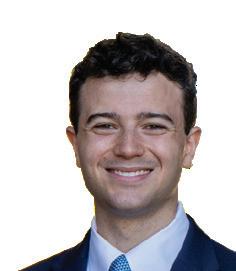

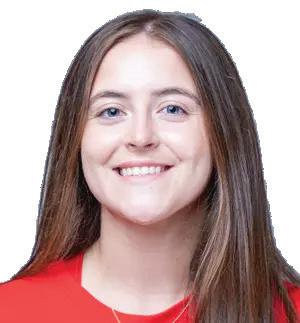
Red’s run game.
When the pressure was put on the Red defense to keep this lead, it delivered. Cornell once again shut down the Bison, allowing no first downs and forcing another quick Bison punt.
Once the ball was back in the hands of the Red offense, its dominance on the ground was once again put on display. The Red rushed for 26-yards that were seemingly uncontested. Once in scoring range, Bass-Sulpizio attempted three passes but would only come away with incompletions. After these attempts, the Red switched back to what was working for them, and Bass-Sulpizio swiftly rushed 12 yards to score the Red’s third touchdown of the game. After a successful extra point attempt from Roost, the score sat in favor of the Red at 23-7.
With the score now heavily in favor of the Red, defense had to ensure that this lead was in safe hands. Sophomore linebacker Keith Williams Jr. did just that when he intercepted the ball on the first play of the Bison’s drive, giving the ball back to the excitement-filled Red offense.
While it was clear the Red had a lot of momentum, the Bison were not ready to give up just yet. Anticipating Bass-Sulpizio’s use of Triplett, the Bison forced Triplett to fumble on the first play of the Red drive.
The Bucknell offense came out strong, however, a botched snap led to another fumble, allowing junior safety Johnny Williamson to recover it. Possession had, at this point, switched four times in five and a half minutes.
“[The defense] plays hard, they run, they hit, they do what they’re coached to do,” said Swanstrom. “I have high expectations for them. Keith [Williams Jr] got the two picks, but we had opportunities all over the place to make a ton of plays down the field.”
To continue reading this article, please visit www.cornellsun.com
Matthew Leonard and Alexis Rogers can be reached at mbl229@cornell.edu and arogers@ cornellsun.com.
